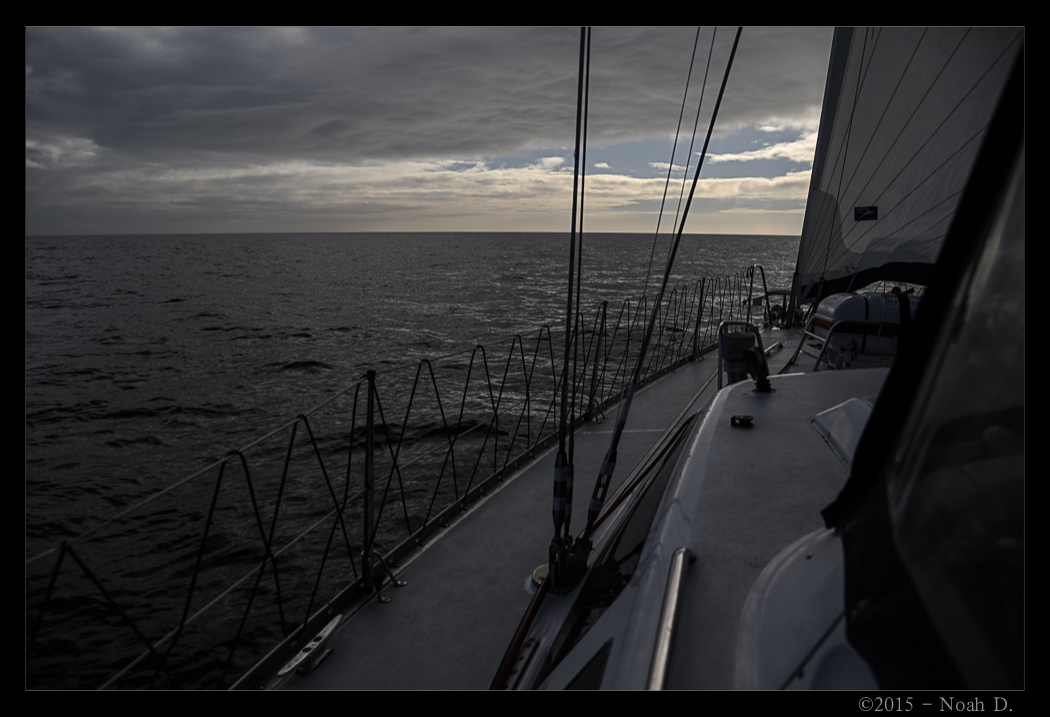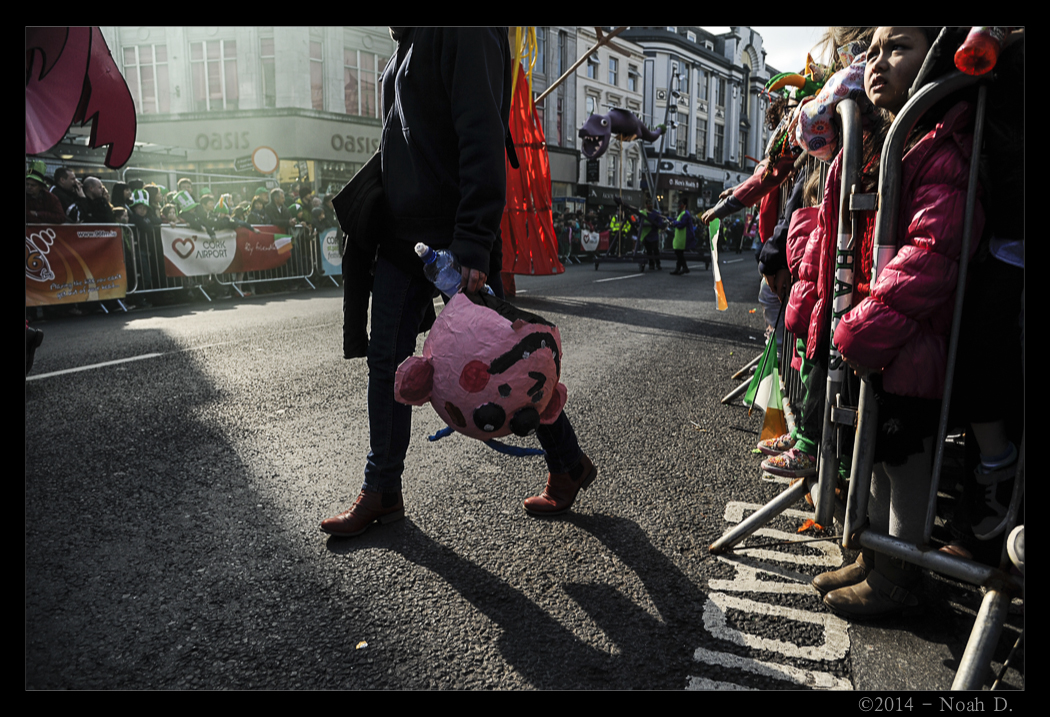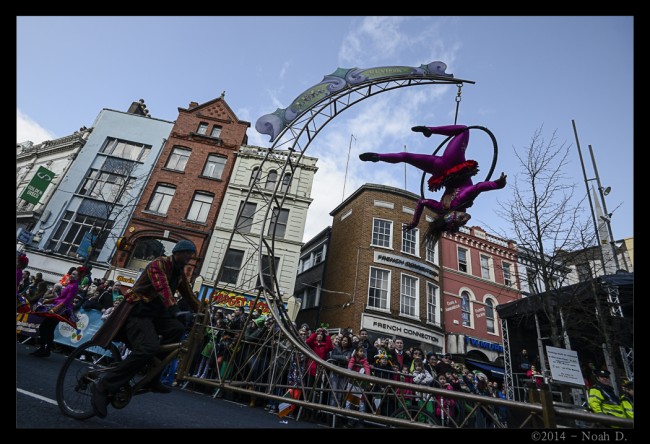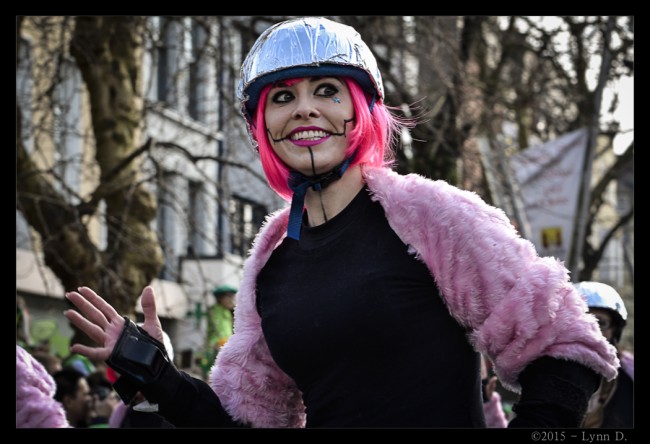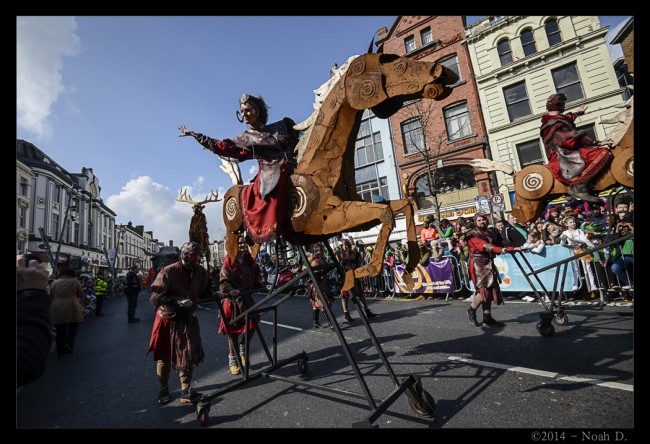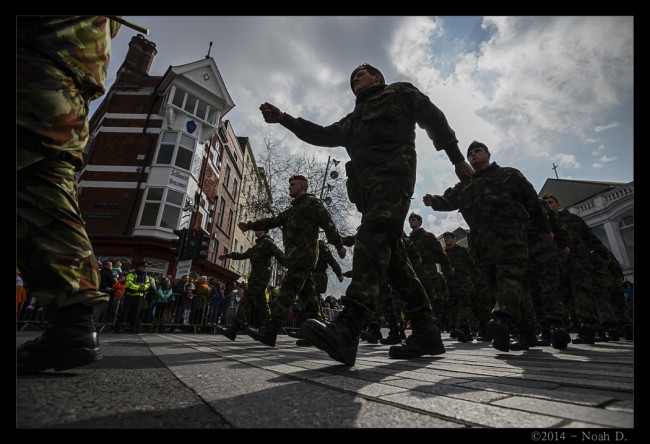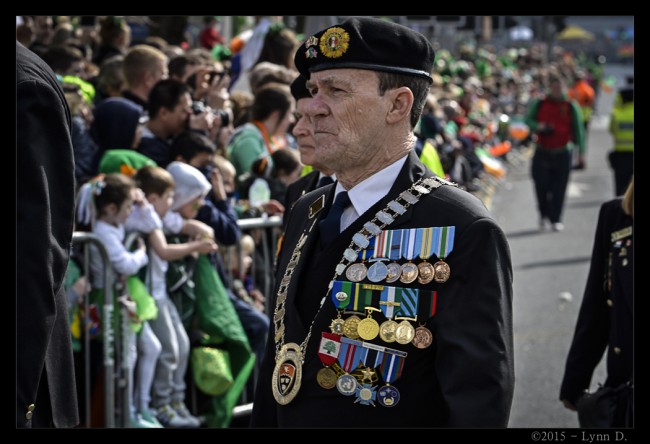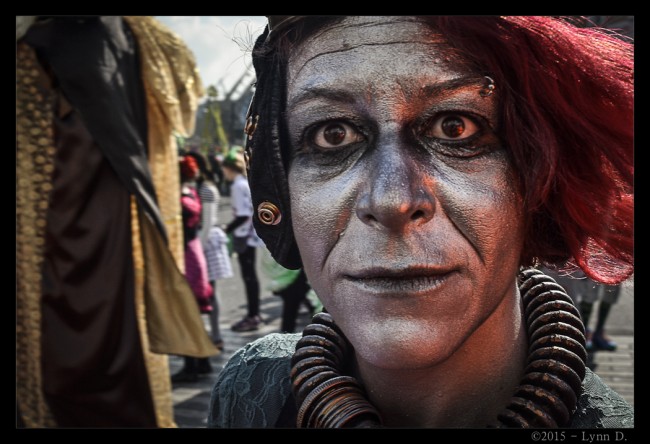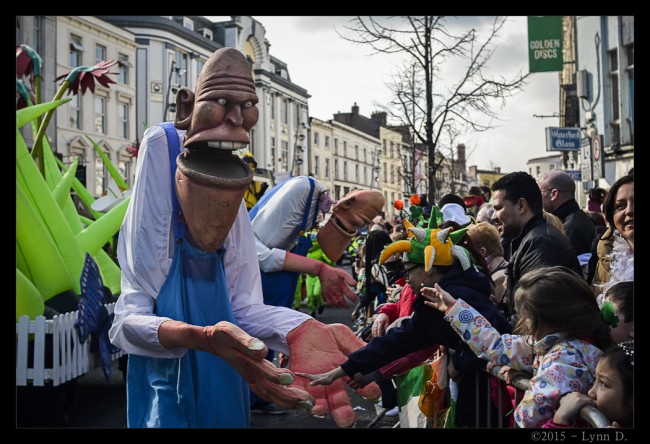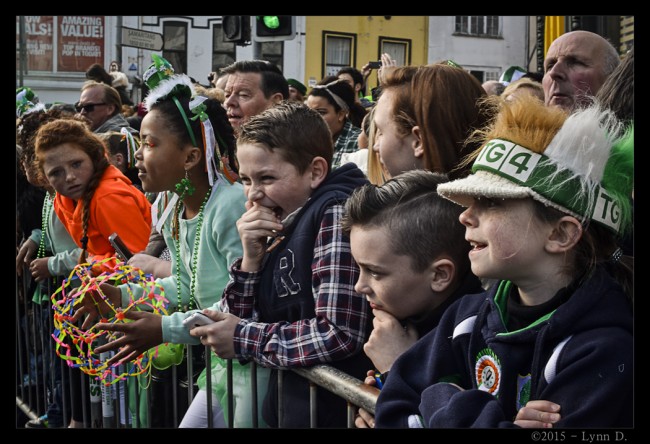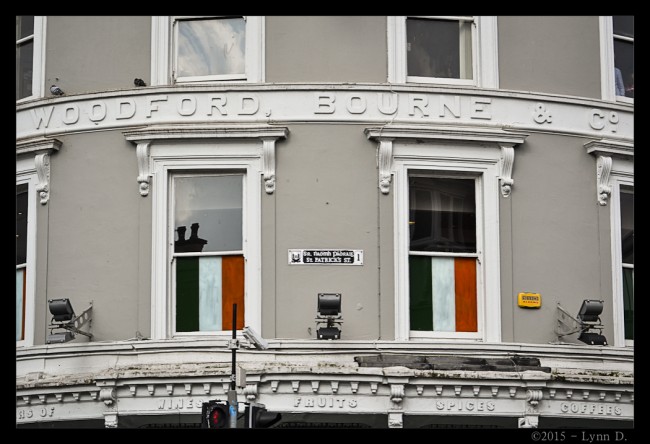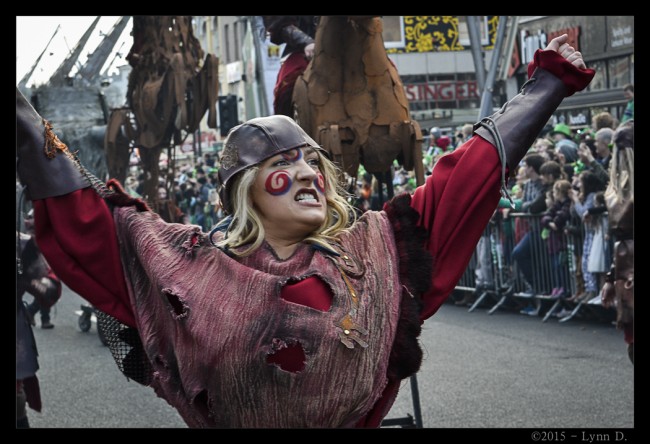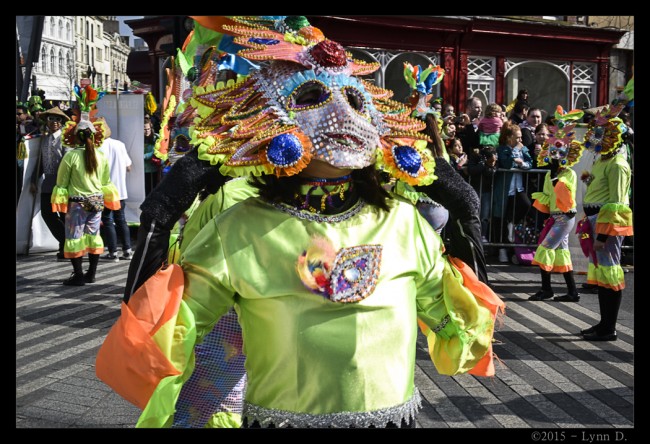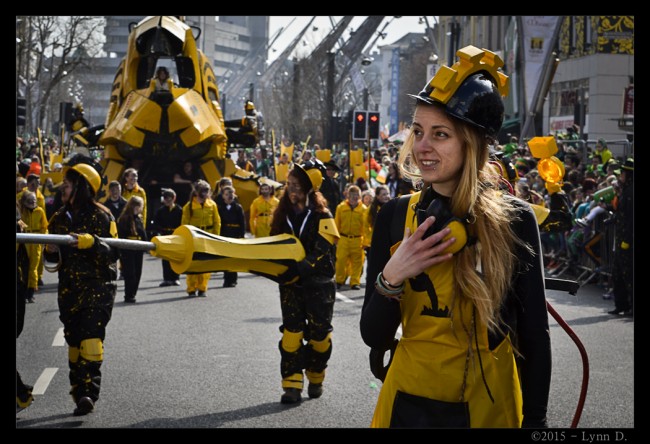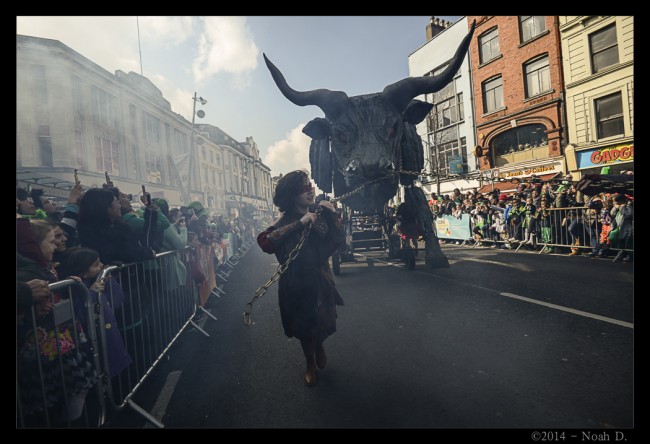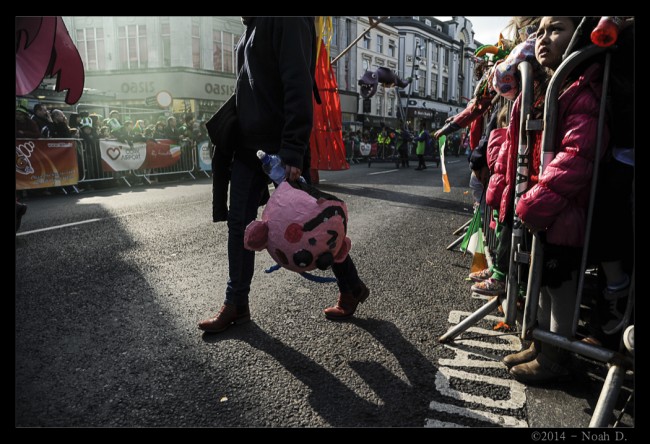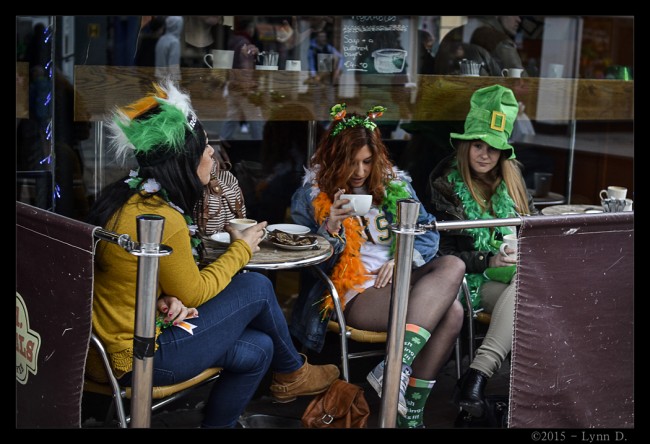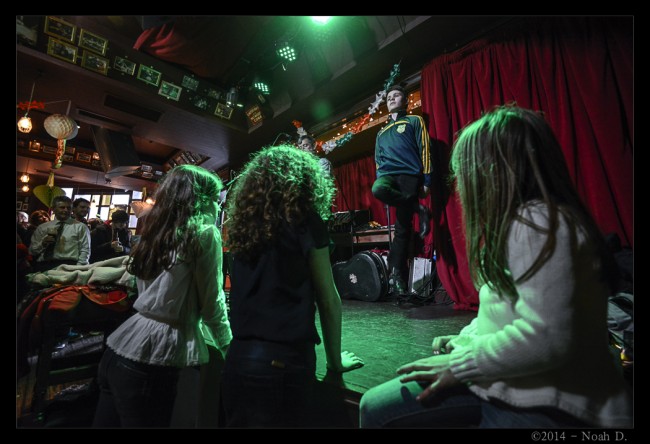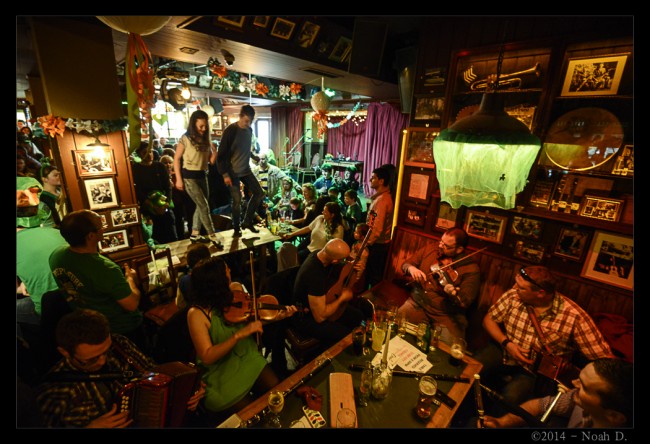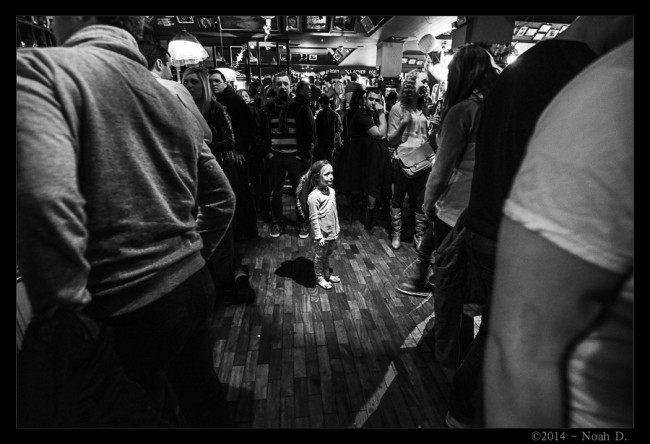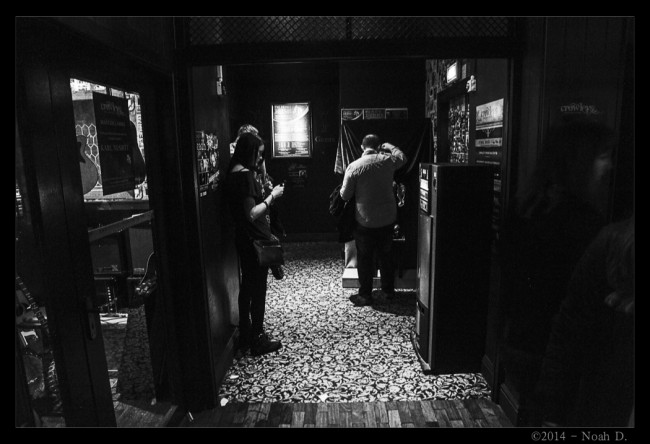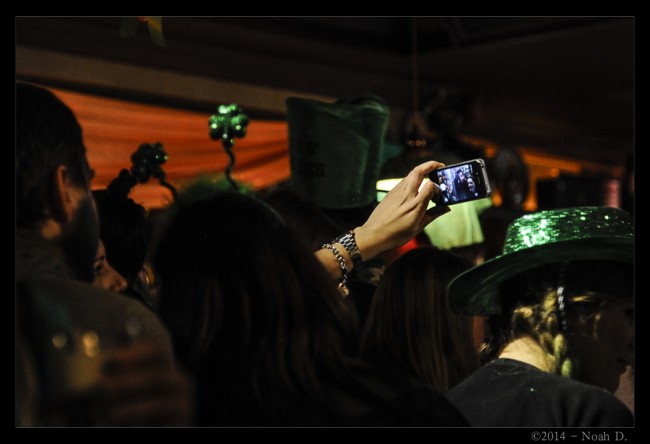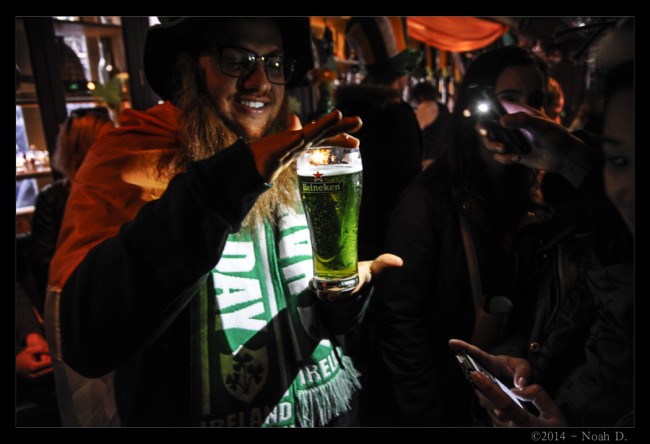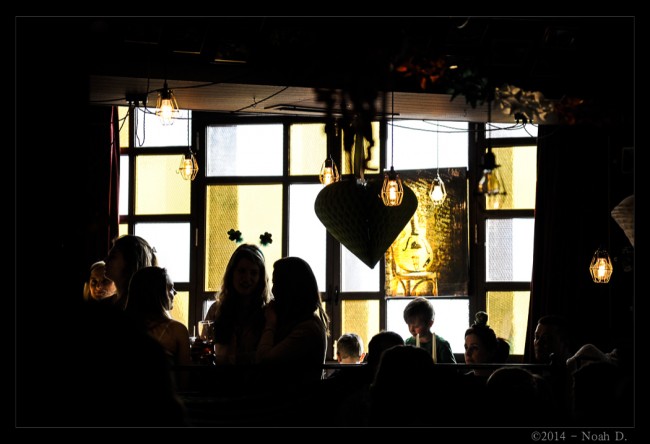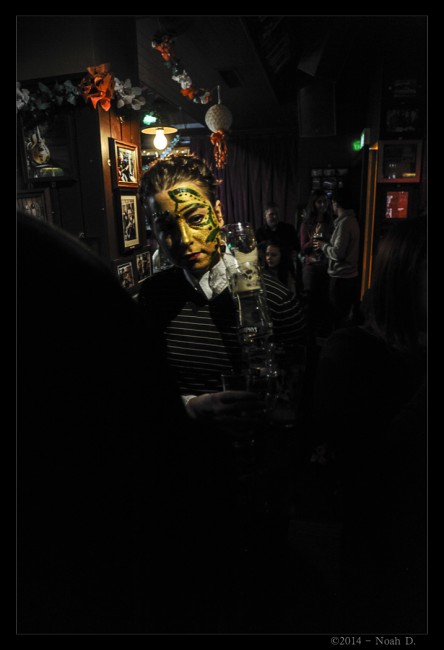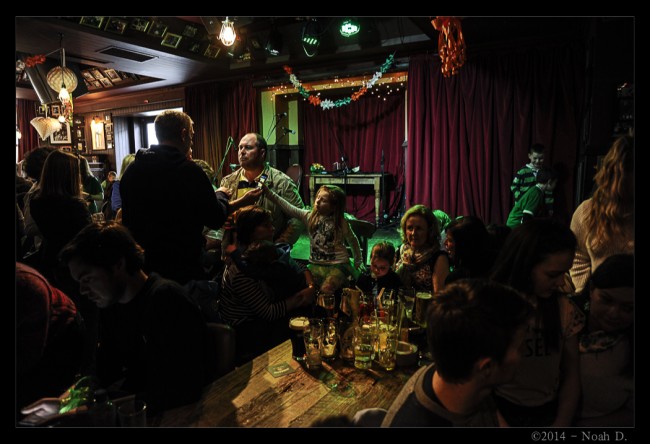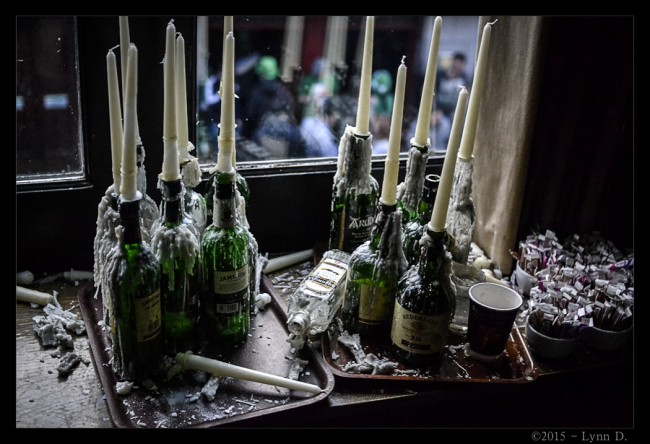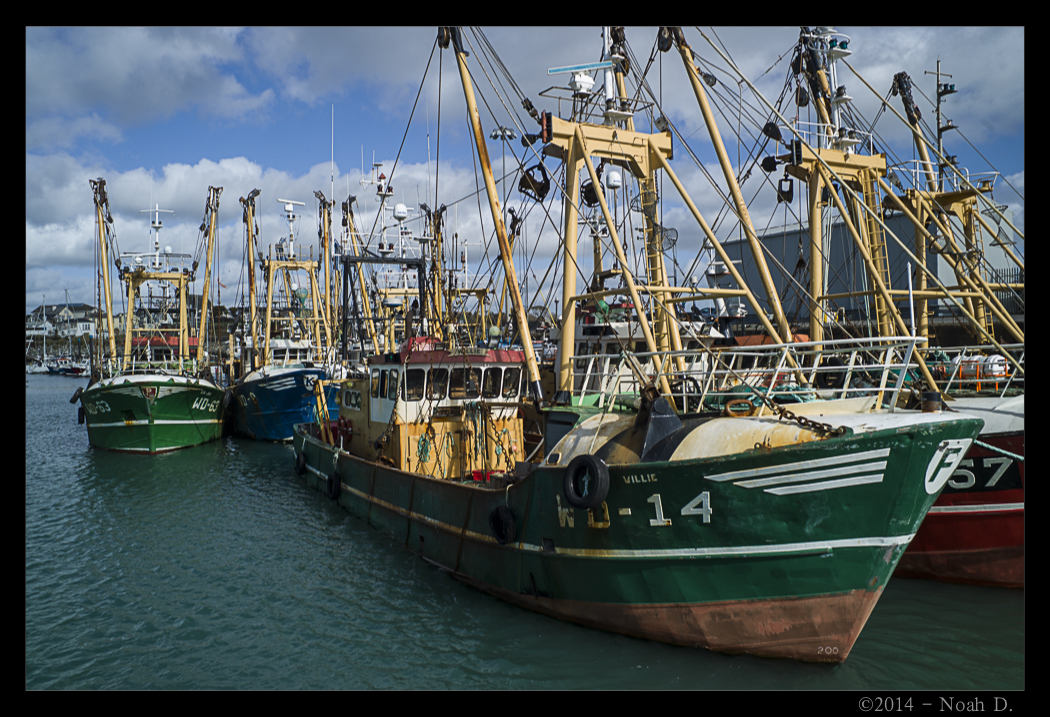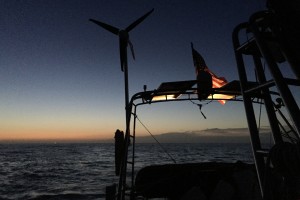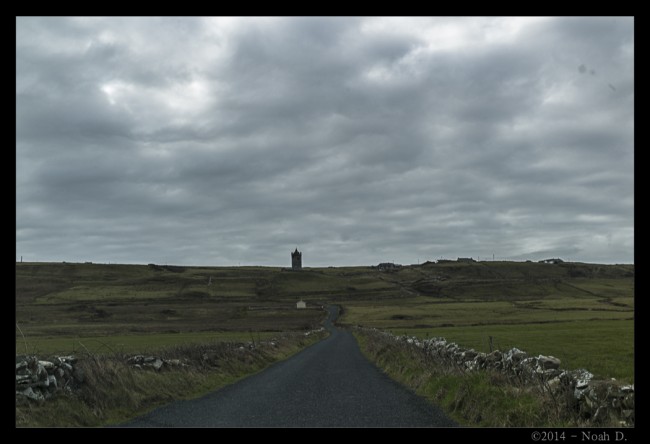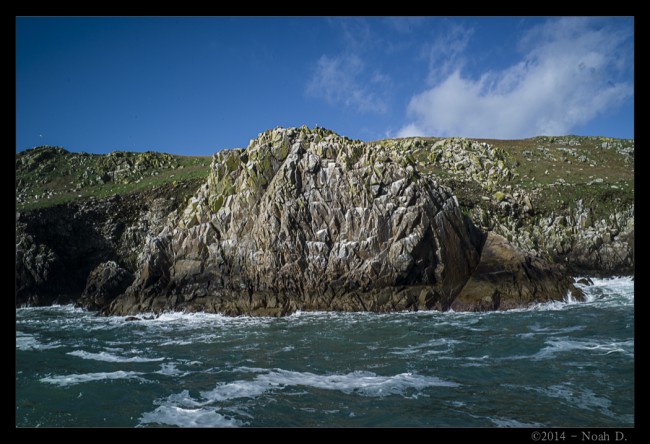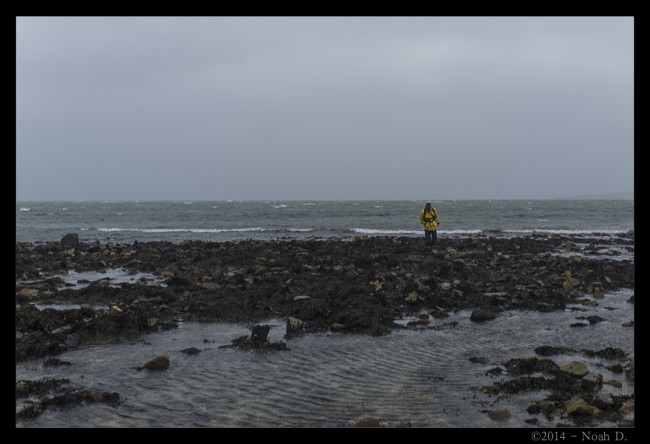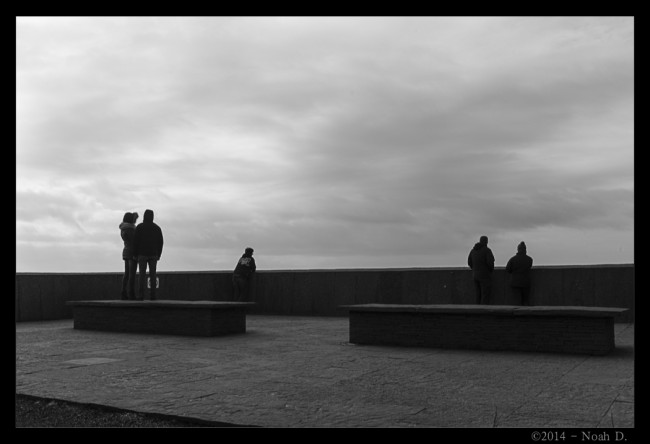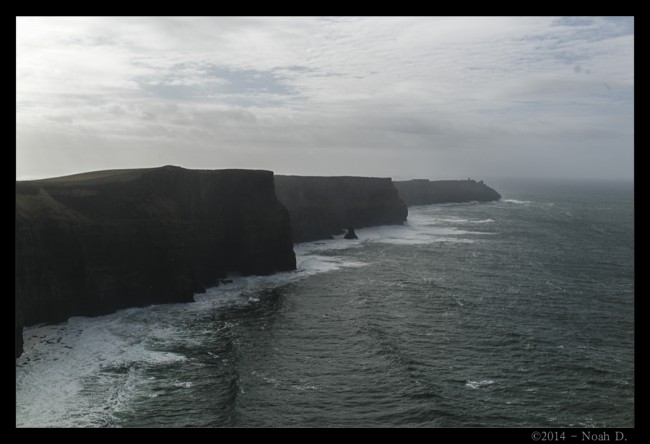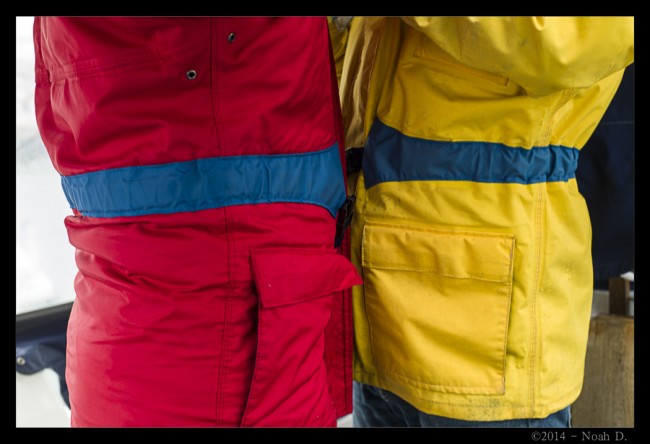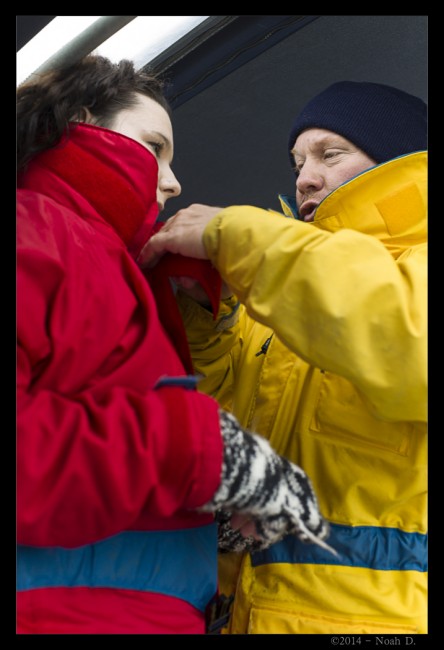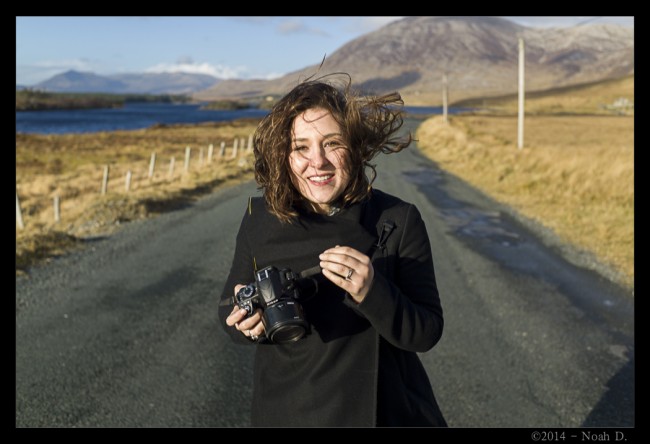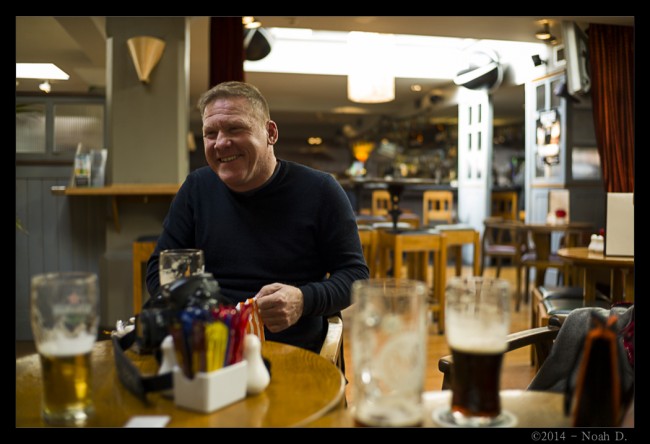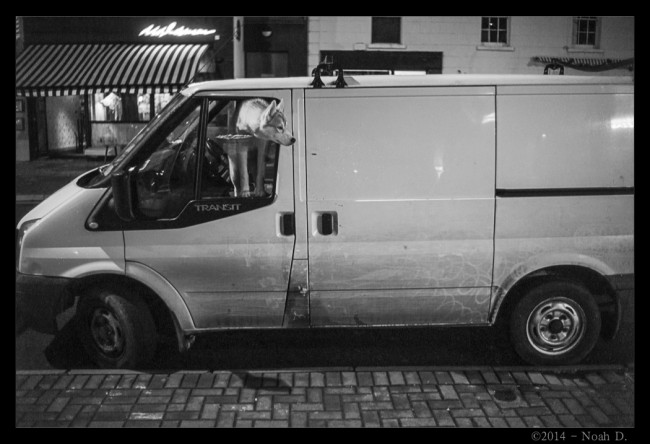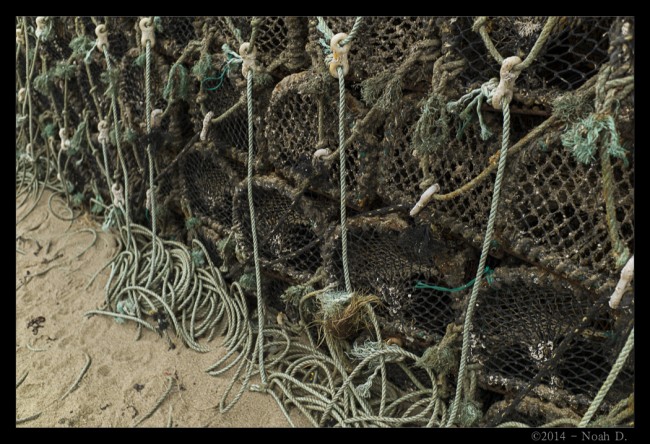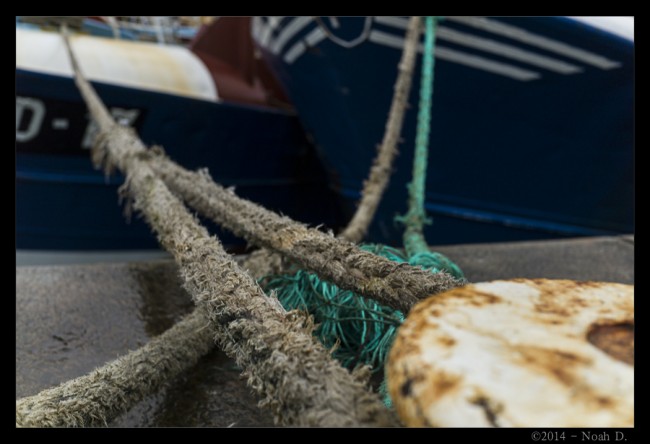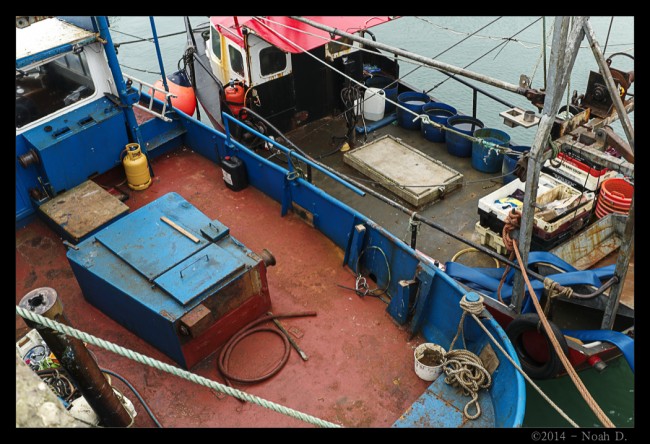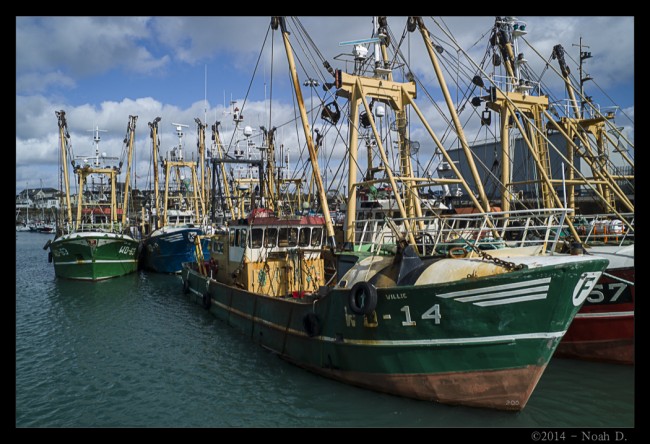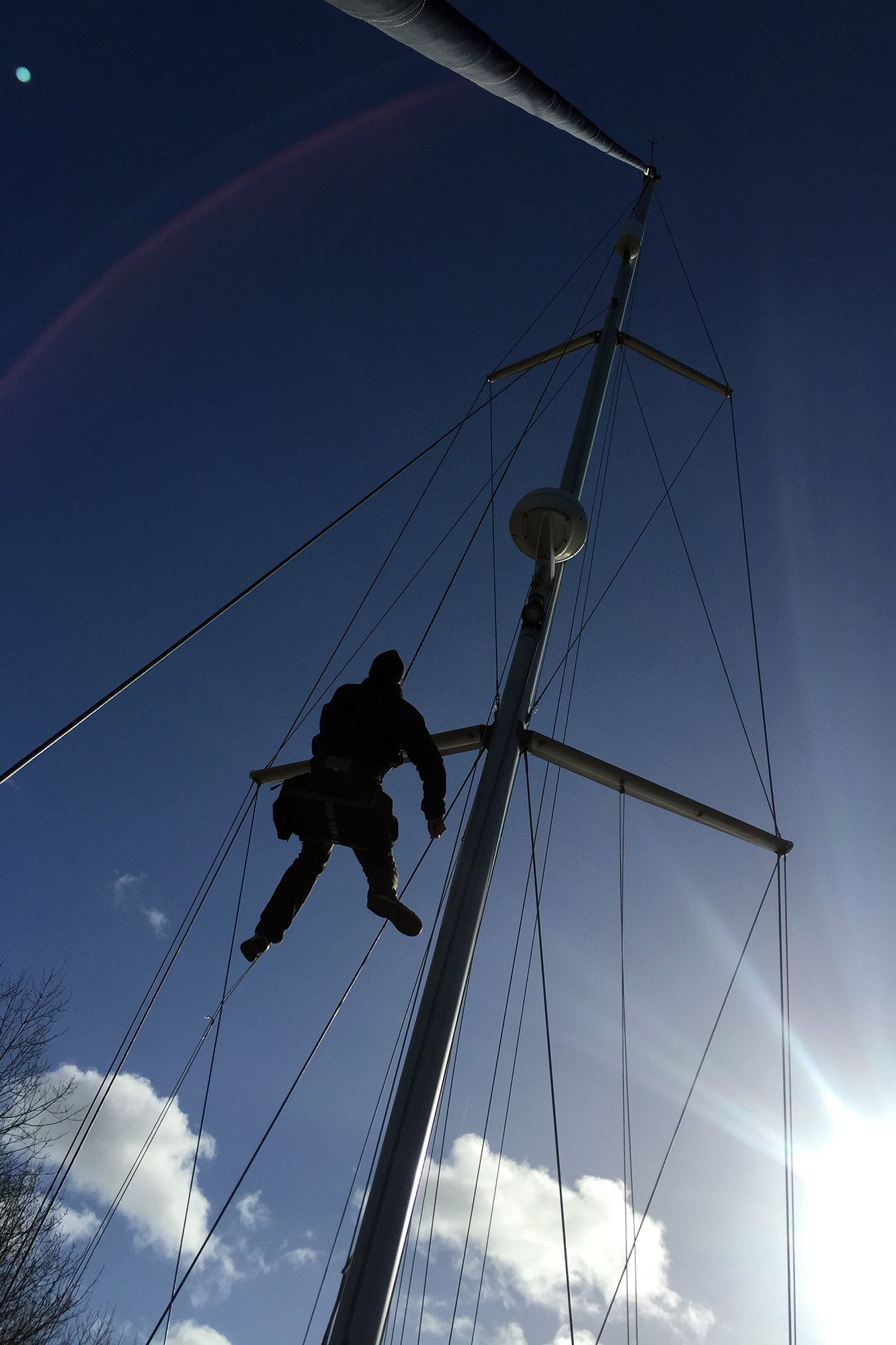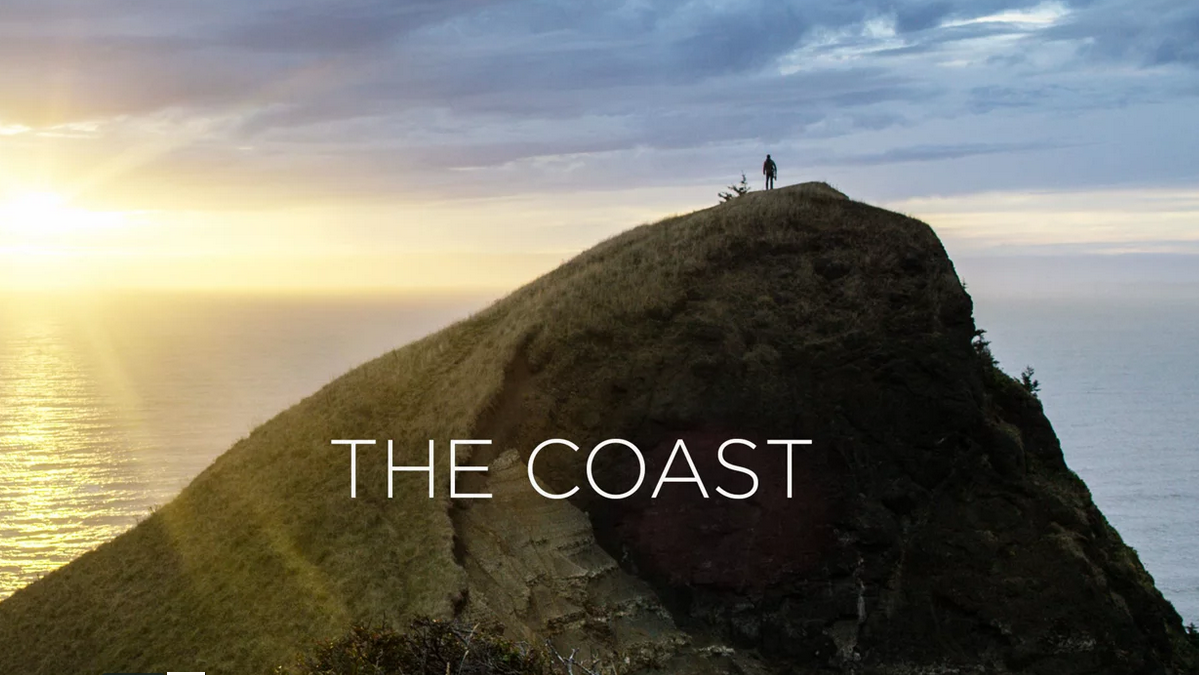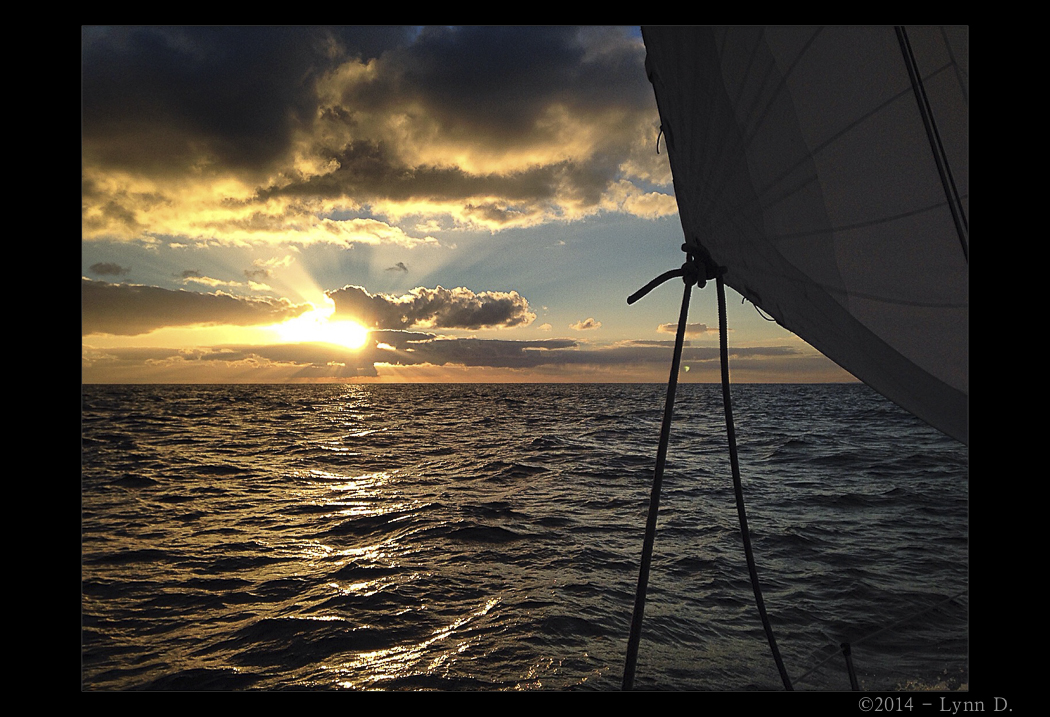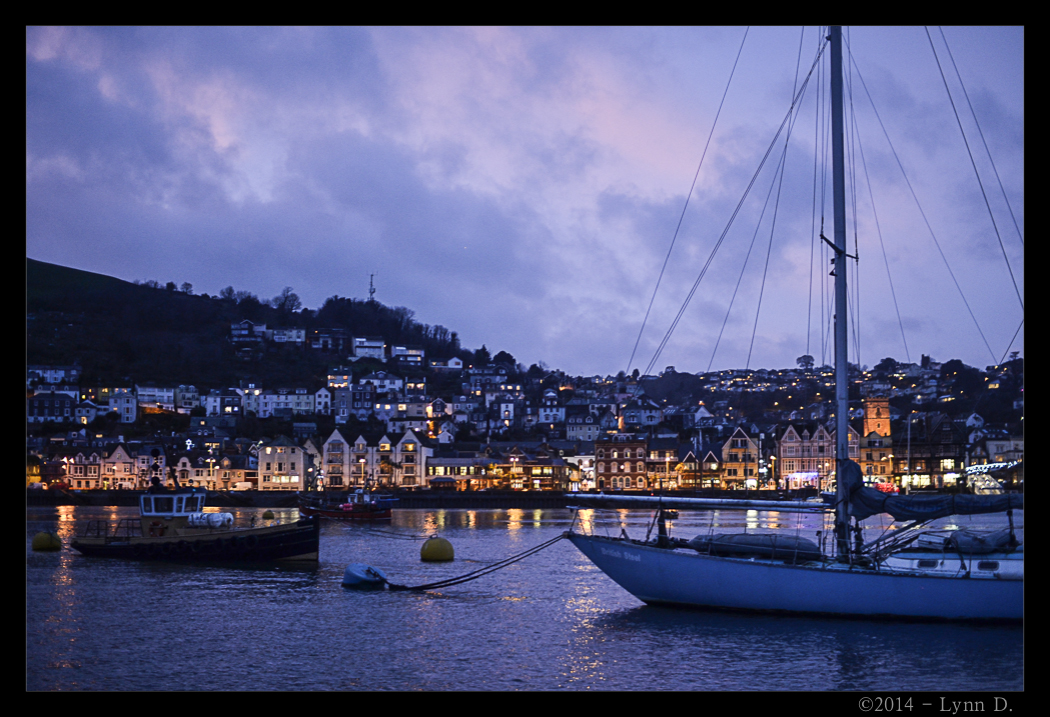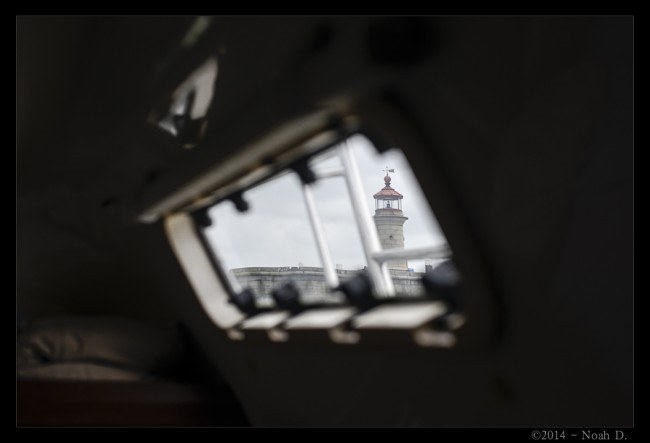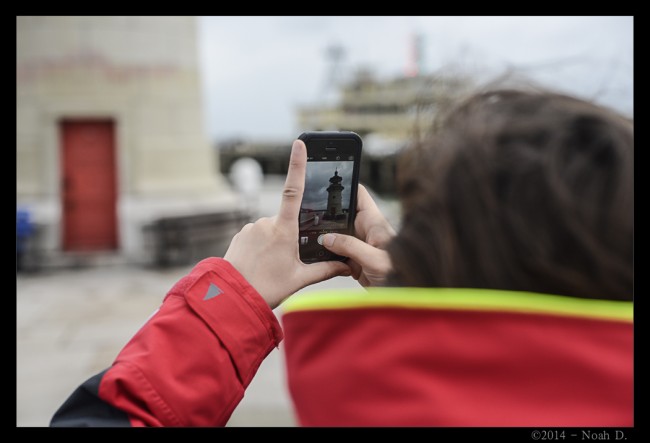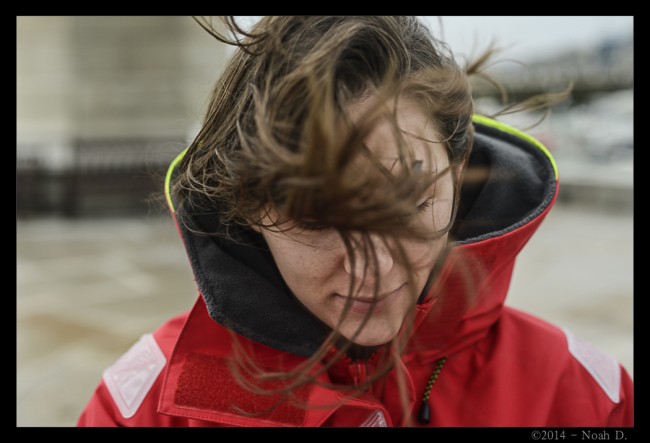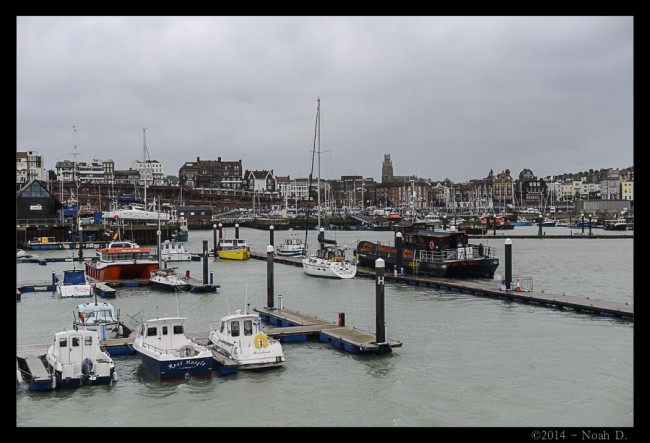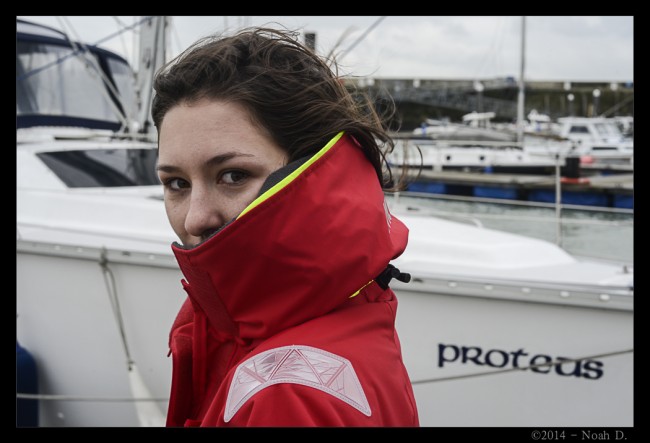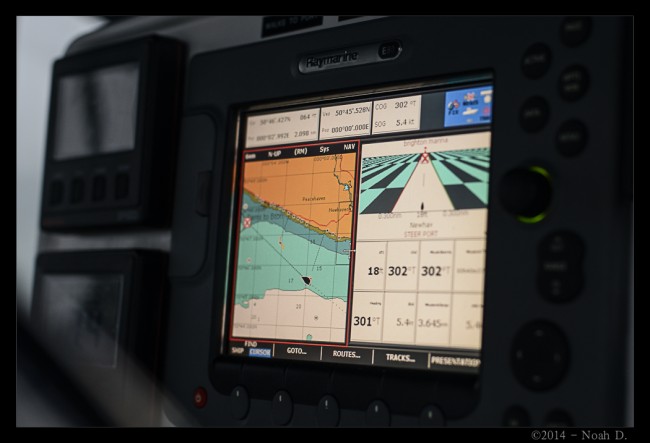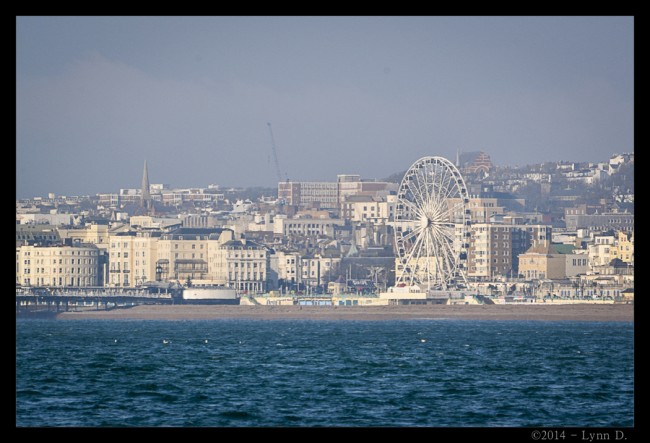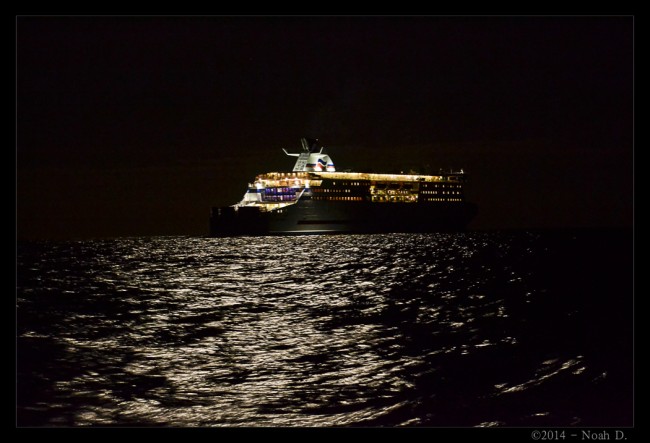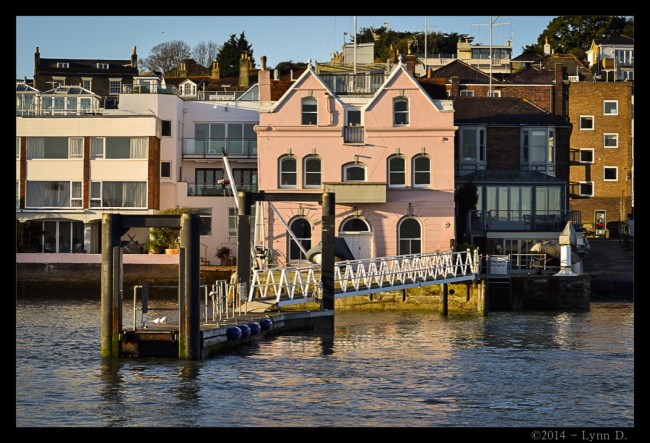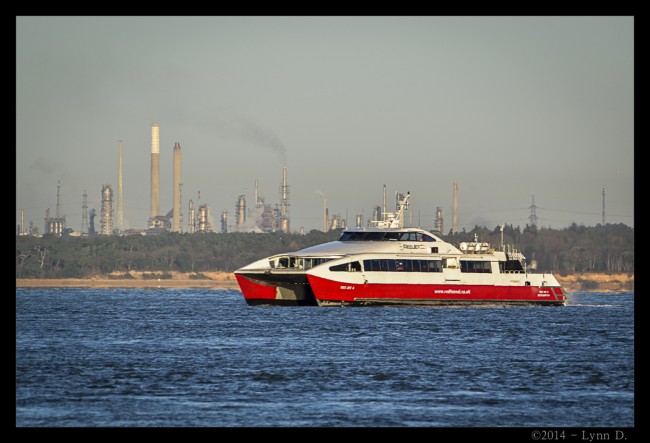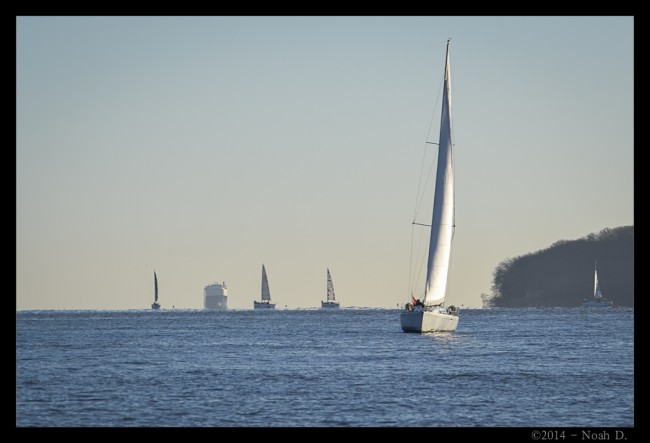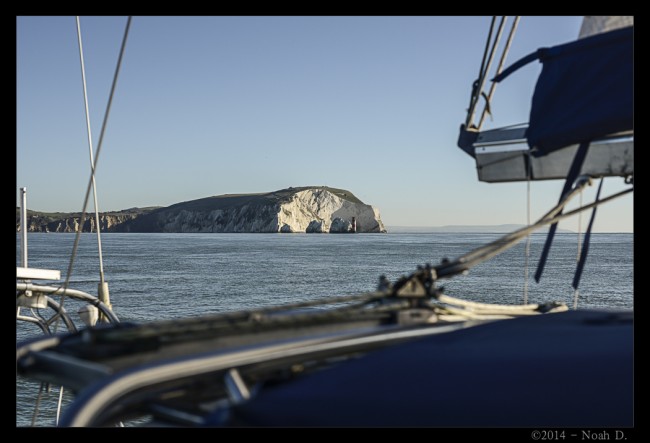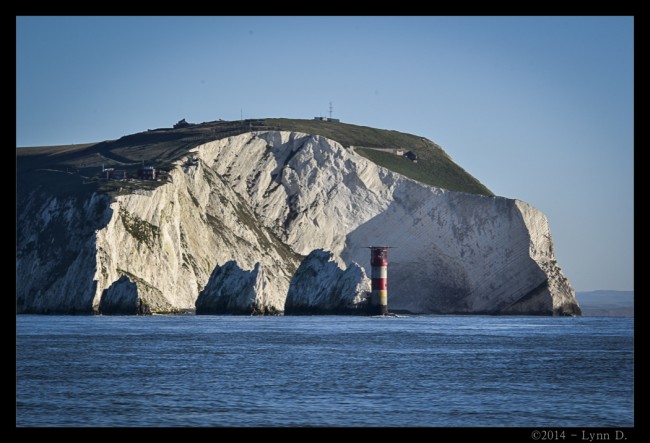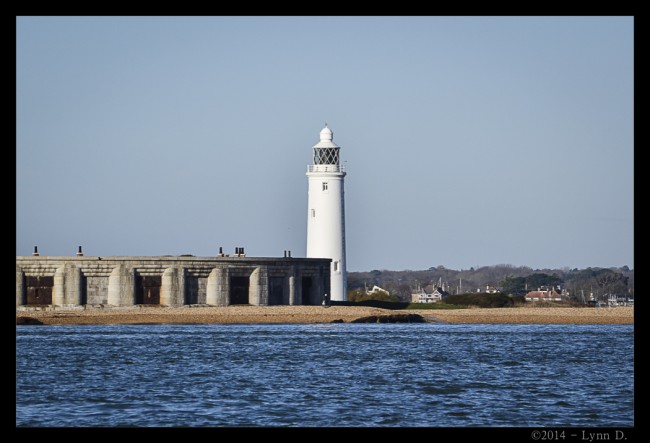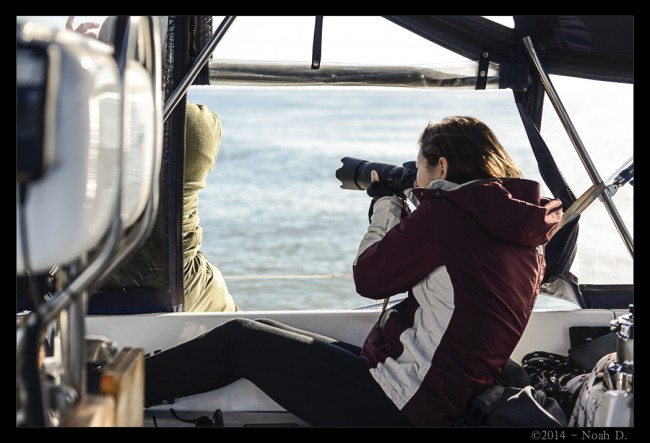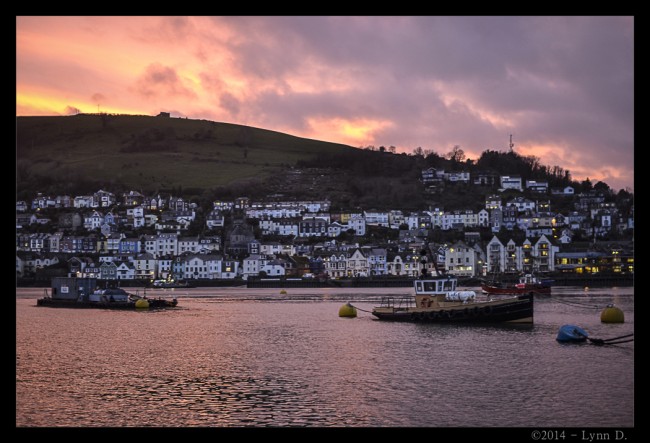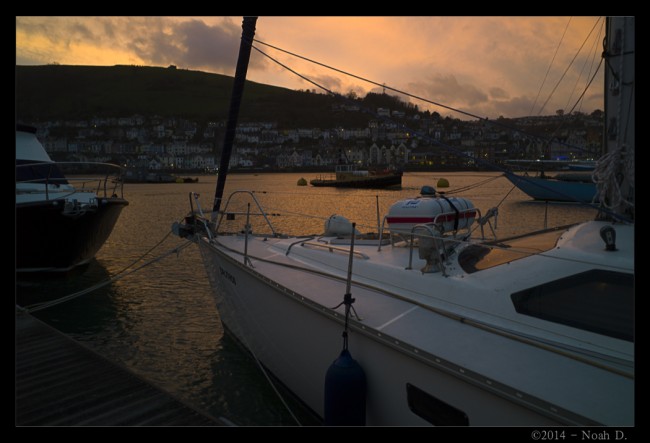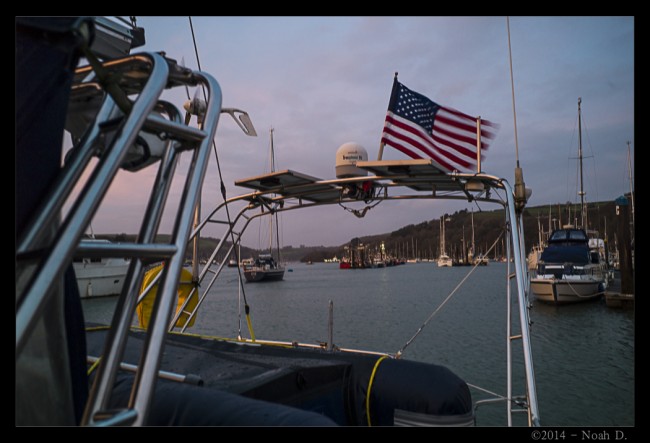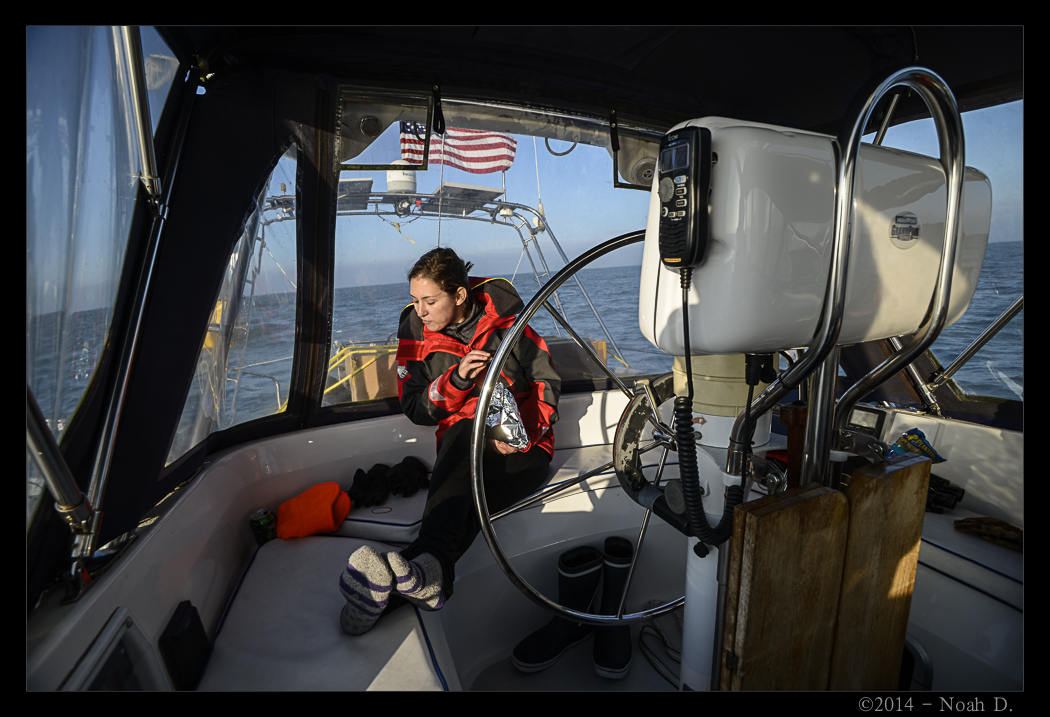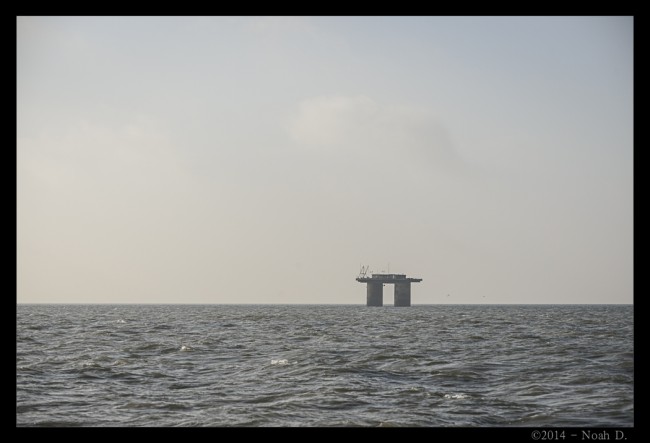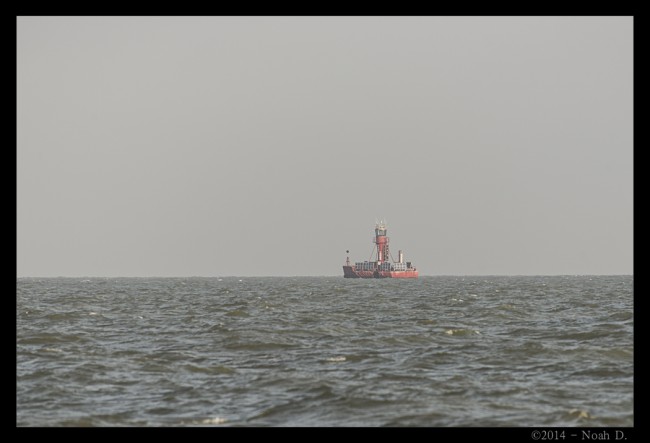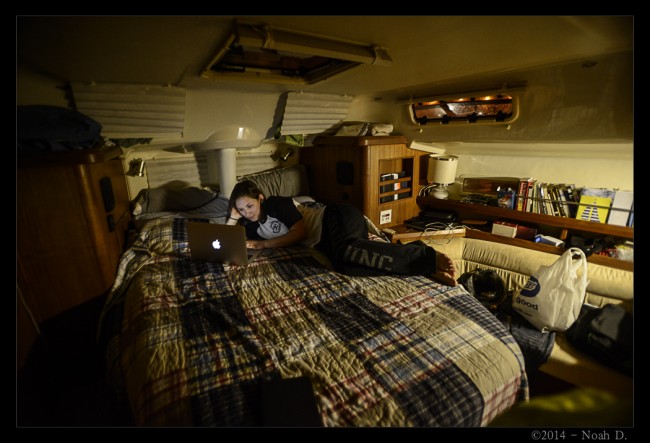“Be not afeared. The isle is full of noises,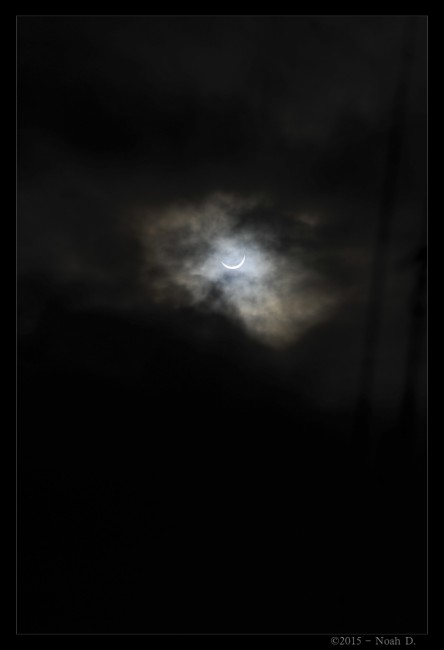
Sounds, and sweet airs that give delight and hurt not.
Sometimes a thousand twangling instruments
Will hum about mine ears, and sometime voices
That, if I then had waked after long sleep,
Will make me sleep again. And then, in dreaming,
The clouds methought would open and show riches
Ready to drop upon me, that when I waked
I cried to dream again.”
~Caliban to Stephano, (The Tempest: Act 3, Scene 2)
Author: Noah D.
In the middle of St.Patrick’s…
By: Noah D.
Travel will teach you things. It will teach you marvelous things. But it will also teach you to fail. Or, rather, teach you that failing is not the end of the story… let alone something to be feared.
We attempted to cross the Celtic Sea on March 14. We made it around 25 miles before turning back: the sea was not having it. Massive swells pushed us farther and farther off course. Simply tacking would only send us back up the coast. Disappointed, we turned back.
And then St.Patrick’s Day came to pass.
What began as a simple call to get tickets at the Cork Opera House for an evening of Irish music somehow turned into various people calling us back. And then we had seats with our names on them in the grand stand for the parade, which turned into access to the parade itself… followed by a brisk walk through the city to a private room in a pub and sat down beside a famous radio personality… and then the Lord Mayor of Cork. They said, “Sit here.” …and there we sat, a constant stream of people greeting the personalities and us not knowing that we were really nothing special.
We experienced St.Patrick’s Day from the inside. We saw Cork with all its dressings on and from behind the curtain.
It has occurred to me that my date stamps are wrong. It is 2015, after all…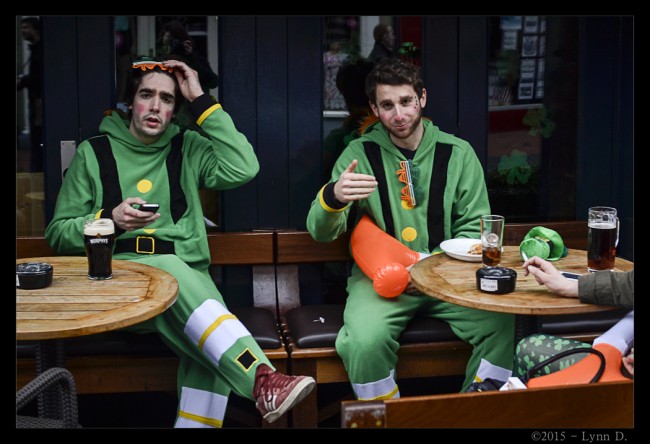
If you seat yourself next to a king, anyone can ask you to get up and move. If a king seats you next to him, only a king can move you. The world is full of people trying to get themselves seated next to a king… or look like they have been seated there. We just got blown in by the sea.
Who knows what disappointment holds? Whatever happens, it is going to be good…
The first miles: Kilmore Quay to Crosshaven…
By: Noah D.
We’ve almost sailed 1,000 miles aboard Proteus. Most of that was coming from Ipswich. And we’ve sailed a little around the east coast of Ireland as far north as Greystones just a few miles outside Dublin.
Ah, but where is home? As we were driving a rental car from a day trip to downtown Cork the other day, Lynn said that she felt as if she is going back home every time we walk or drive or ride back to Proteus. It is as normal to walk or drive in obscure lands (even after a mere six months aboard) as others might drive through the same subdivision in which they grew up and now have families of their own. We might be in a random marina or boat yard, but those are just the changing scenery – like a scene from “Inception” in which the world is able to be folded back on itself or flicked through with each tumble down the rabbit hole. We land in a place and it immediately becomes “the street where we live” and the dock is the sidewalk to our front door. We step onto Proteus and down the companionway and we are suddenly home.
In a few short weeks, we will likely be in tropical climes and dealing with five or six layers of sunscreen instead of five or six layers of clothes to go out and watch for crab pots. And then that will be our home, all hot and sweaty, our beds draped with mosquito nets.
Without as much as a flutter of wind, we departed Kilmore Quay in the wee hours before dawn on 10 March. The earlier the better because a slight gale was forecasted for the northwest and we wanted to be in Cork before it got messy. There was about 2-3m swell coming from the Atlantic, so motoring was a little hurk-worthy until we got the sail up a few hours later. It doesn’t take much wind to get Proteus moving nicely, but 2-3kts is aggravating.
All in all it was a great first sail down to Crosshaven. We sailed into Cork harbour almost perfectly downwind just as a big rain cloud appeared on the horizon obscuring an otherwise great sunset.
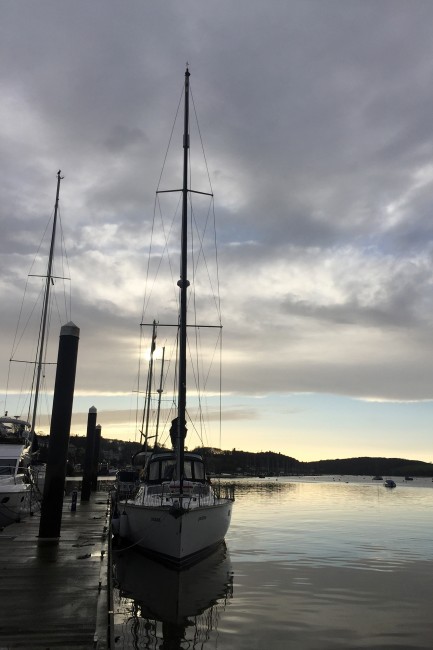 Now, why Crosshaven? Why didn’t we just cross directly from Kilmore Quay down south to France? It is almost exactly the same distance from Cork to Sevenstones or Scilly as it is from Kilmore Quay. The difference is the motion of the ocean and the prevailing winds. Coming 70-80 miles farther west will put the (occasionally significant) Atlantic swell on our quarter rather than on our beam. Also, the winds, if directly from the south, would force us to tack back and forth into and out of the Bristol Channel… and all the crazy tidal currents that entails. Hopefully, from Cork the wind will be more favorable, and, even if it is directly on our nose, we will be able to tack less and/or simply let the wind be our guide and suck us across the English Channel to Brittany.
Now, why Crosshaven? Why didn’t we just cross directly from Kilmore Quay down south to France? It is almost exactly the same distance from Cork to Sevenstones or Scilly as it is from Kilmore Quay. The difference is the motion of the ocean and the prevailing winds. Coming 70-80 miles farther west will put the (occasionally significant) Atlantic swell on our quarter rather than on our beam. Also, the winds, if directly from the south, would force us to tack back and forth into and out of the Bristol Channel… and all the crazy tidal currents that entails. Hopefully, from Cork the wind will be more favorable, and, even if it is directly on our nose, we will be able to tack less and/or simply let the wind be our guide and suck us across the English Channel to Brittany.
As always, the weather is extraordinary. I cannot believe how random it is! Just the other day, since we’ve been watching for this upcoming crossing, there was a huge weather system that was going to push 8m seas and 50kts wind into the Celtic Sea on Tuesday or Wednesday of next week… then, I checked it yesterday and it was completely gone, not a stitch of wind increase for the next week. It must be that time of year.
Ireland has been good to us, but, if all goes well, our next update will be from France. Stay tuned…
[UPDATE: We aborted our first attempt crossing to France after the sea state worsened to 3 and 4 meter swells on our beam and a crossing wind on our nose. Beating upwind and heeling into major swell is miserable, slow going: for every step forward, we were taking two steps sideways. We’re still in Crosshaven for another few days waiting on the conditions to improve… I’m okay with that!]
…but our new crew and travel companion is Philip. More on him at a later date. 😉
Proteus is our child…
By: Noah D.
What on earth have we been doing for the past month of silence on this blog?
Everything under the sun. (Well… whenever there is sun.)
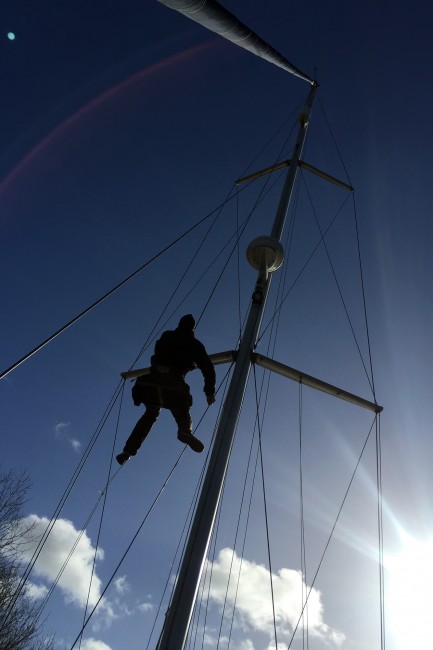 I’ve installed the new AIS and VHF splitter (which required running a second GPS receiver, a new NMEA cord to the helm chartplotter – I had to wait on it to come from the USA – and the physical installation of the units in a tiny little space) and I found how much a mess the nervous system of this boat is after 20 years of build-up. (And whoever did it was insane.) I dismantled one toilet entirely to unblock a blockage and partially disassembled the other to install a proper anti-siphon… which proved to me that I have my Dad’s iron stomach. New LED navigation lights are also installed… the old ones stood full of water half the time. However, now the green side has a decidedly blue hue, but they are super bright. Also, we installed all new LED interior lights and red night lights after two fixtures decided to go out completely. Lynn has been up the mast twice: once to retrieve the lazyjack halyard that broke during the Celtic Sea storm… and then again a few days later because I dropped it and it ran 20ft up the mast. And speaking of lazyjacks, we got everything restitched and I rebuilt the track on the side of the boom (that had also been ripped off in the Celtic Sea). The whole cockpit enclosure and dodger has been removed, treated, restitched, and reinstalled… we had a dodger window blow out during a storm. We have two new halyards and a clean bill of health for the rigging after a survey.
I’ve installed the new AIS and VHF splitter (which required running a second GPS receiver, a new NMEA cord to the helm chartplotter – I had to wait on it to come from the USA – and the physical installation of the units in a tiny little space) and I found how much a mess the nervous system of this boat is after 20 years of build-up. (And whoever did it was insane.) I dismantled one toilet entirely to unblock a blockage and partially disassembled the other to install a proper anti-siphon… which proved to me that I have my Dad’s iron stomach. New LED navigation lights are also installed… the old ones stood full of water half the time. However, now the green side has a decidedly blue hue, but they are super bright. Also, we installed all new LED interior lights and red night lights after two fixtures decided to go out completely. Lynn has been up the mast twice: once to retrieve the lazyjack halyard that broke during the Celtic Sea storm… and then again a few days later because I dropped it and it ran 20ft up the mast. And speaking of lazyjacks, we got everything restitched and I rebuilt the track on the side of the boom (that had also been ripped off in the Celtic Sea). The whole cockpit enclosure and dodger has been removed, treated, restitched, and reinstalled… we had a dodger window blow out during a storm. We have two new halyards and a clean bill of health for the rigging after a survey.
What do we have left? Our generator is still not running right. Some of Ireland’s best and brightest mechanics have been working on it and there’s still something amiss. It’ll come around…
Also, we’re going to have the boat lifted out briefly for a bottom spray before our trip south. It is amazing how much crap grows on the bottom of a boat in 6 months… even with good anti-fouling!
Finally, we’ve been out for a little sail up the coast from Kilmore Quay to Arklow. And we’ll be in Greystones before too long to be close to Dublin for final provisioning and picking up our new companions for the Big Trip south.
Expect the updates to come more frequently as we begin our adventure. I hope you’ll stay tuned…
Return to the Quay…
By: Noah D.
At long last, we have returned to Proteus. We were gone exactly one month. To the day. We left to spend Christmas with family; after all, we were unable to go home for Christmas last year due to my university work and Lynn’s job. All was not all quiet in Kilmore Quay, though. Since we left, there were a number of pretty severe storms and “Weather Bombs” including one that peaked at Force 10.
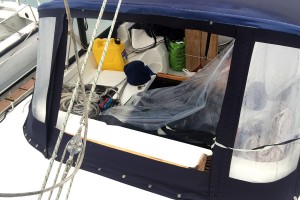 Considering that the only damage was a blown-out vinyl window that was already a little weak with UV-damaged stitching, I think we came out okay. No wonder all the rest of the boats in the harbour are completely stripped down!
Considering that the only damage was a blown-out vinyl window that was already a little weak with UV-damaged stitching, I think we came out okay. No wonder all the rest of the boats in the harbour are completely stripped down!
Completely unrelated to the storms, there is always something that you come back to that you didn’t expect: thankfully there was no extra water in the bilge, but the Webasto/Airtronic heater didn’t come on. Since the temperature hovers around freezing most nights, this was not something to shrug off! Must fix. Press the button and… no go. Fiddling with it a while, I figured out that the pump had run dry – no fuel in the lines. Lo and behold, it turns out that there is no need to prime these pumps: they will re-prime themselves after turning the system on and off a few times. And by “a few times” I mean… like… a dozen. We were slightly concerned that we would be sleeping under two quilts and a duvet until I got it fixed, but enough Google-ing and you can fix anything! These heaters are really amazing. They’re super smart and it almost seems like they self-diagnose and repair.
But, really, there’s not much else out of place… besides the fact that everything is impossibly messy and cluttered. Such is boat life sometimes…
Otherwise, over the next few weeks, we will be working on various and sundry systems. Needless to say, we’ll be having a canvas repair person out. And the genset needs some work. And we’ve got a new AIS to install and such, so please stay tuned. The count-down to our Big Trip across the Atlantic is less than 40 days away.
The allure of The Coast…
We’re headed back to Ireland and Proteus tomorrow. Perhaps needless to say, we are missing our home. It has been a great few weeks of vacation in the States with family, but it’s time to get back and get serious: we have an ocean to cross.
With that, I’ll leave you with a really beautiful video that all coast-wise humans might connect with…
The Coast from NRS Films on Vimeo.
…and have a great day! See you in Ireland.
The shakedown of Proteus…
Before simply doing, one cannot know certain things. And beyond any other fear, the fear of the unknown is the Chief of Fears. A shakedown cruise on a new sailboat in new waters as a new sailor… it is a time to dispel fears.
We sailed almost 700 miles of learning. And more was learned in these past few weeks offshore than nearly 15 years of sailing and racing inshore. For that matter, the first day out crossing the Thames Estuary, we almost doubled our mileage that we had previously sailed in a single day with Proteus. And the firsts just kept on coming. Here’s a few things we learned from the shakedown…
Proteus is capable
One of our greatest concerns was not quite knowing how far is “too far.” But after handling gale-force winds (and crazy high gusts) and, on occasion, four meter seas, it is becoming apparent that the Hunter Passage 42 is a well-built yacht. How big of a wave can it handle? How much water comes into the cockpit after breaking through a cresting wave? How high can the winds be before that second reef needs to be put in?
Had we been sailing in a mild winter day in the tropics, I’m not sure we would have known such things. We needed to surf a breaking wave over the bar into Salcombe Harbour. We needed to run before the wind in an Atlantic gale. We needed to sit on a Cowes mooring ball and feel the motion of the crossing tide and the winds against us. And we needed to dodge all those silly crab pots in the cold, clammy darkness and have the dolphins lead us into the harbour. How else would we have known these things?
High-latitude winter sailing sucks
If the theme of this post is “find out by doing”… then I know what I don’t want to do anymore of: sail above 50ºN in the winter. Most of the time it feels like sailing inside of a sock in a broken washing machine. It is wet. It is cold. It is dark. The weather windows are measured in hours rather than days. And the weather can be quite severe for many days on end. The south coast of England is absolutely beautiful, but we did not see much of it beside what was visible during the 7.5 hours of daylight. A 0600 departure time left us with two more hours of total darkness, then about an hour of dawn-ish blur, followed by only about six hours of usable daylight – with the sun skimming along the southern horizon – then a rather lengthy dusk and twilight… to total darkness around 1630 or 1700.
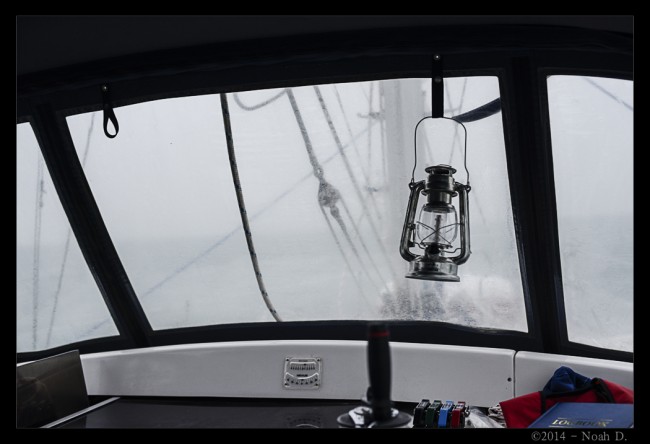 It is no wonder we were the only boat in the harbour and harbour masters kept telling me: “Take any available spot, we’re not busy this time of year.” We were the only crazies out in December moving a boat on the English Channel.
It is no wonder we were the only boat in the harbour and harbour masters kept telling me: “Take any available spot, we’re not busy this time of year.” We were the only crazies out in December moving a boat on the English Channel.
Some people love it. Some people swear that sailing in places like Scotland and Norway is unbeatable. And even though Proteus is built for a certain amount of high-latitude sailing – having so many redundant heating systems on board – there’s only so many layers of pants you can put on while out on deck. Still, there’s a reason why “they” always say of high-latitude anchorages: “We had the place to ourselves!” even in the middle of the summer. It just isn’t enjoyable enough to want to keep submitting ourselves to the bad parts…
…speaking of which:
Seasickness is miserable
Again, I blame the season on this one. I know, it happens to everyone at some point, but a combination of the Atlantic swells and the darkness and the wind direction and the inconsistent motion makes for a perfect storm of conditions to unsettle the most concrete constitution. It hit Lynn the worst, but we both suffered from it at least a few minutes on almost every passage. Particularly around nightfall when everything gets good and disoriented, that Blah Feeling would set in.
Sucking on things like peppermints and Fisherman’s Friend was surprisingly effective. Also, the Dramamine/Bonine pills would hold it at bay. Now we’re moving on to the Scopolamine patches. I really can’t imagine normal seas being so upsetting, though. I can only hope that 40ºN will see those patches in the medicine bag along with our third layer of socks.
Interesting thing we learned, though, is that if you eat easy-peeler clementine oranges while you’re seasick… it makes it far more pleasant when it comes back to visit.
Keep thy waste tank under control
Whether you take the far offshore option and pump overboard or take the far grosser option and pump out, one must – and I stress: must – keep away what we call “The Phantasm.” One night, a certain of our party simply flushed the forward toilet… and the resulting tiny pressure release (burb) actually caused a smell so violent and evil that it literally woke me up… in the aft cabin with the door closed.
What is the reverse of “Batten down the hatches!”?
Now, I don’t mean to be indelicate, but I’ve traveled in some places where I have experienced some wildly disgusting things: a blackwater tank surpasses all. The next day we took care of the issue and have been very careful about it ever since.
On a similar note, vinegar is amazing for keeping toilets clean. And it keeps away the Phantasm (for the most part). But it is vinegar… it is good for everything.
Things break
And maybe it is not that they “break” as much as they “wear out.” When you purchase a 20 year old boat, you’re also purchasing all its problems along with all the things that are reliable about it. Before our Transatlantic in a few months, I have a multi-page list of things that are going to be fixed, adjusted, updated, replaced, or just slathered in lubricant.
For example: the Hunter Passage 42 was built with no red lights. And, of course, 20 years ago, LEDs weren’t something that could be found on the consumer market. Finally the price is coming down and it is affordable to replace old bulbs with completely new low-amp LED fixtures.
Sailing is ACTUALLY enjoyable
In nearly 700 miles of sailing the entire south coast of England from Ipswich to SE Ireland, we only have had ideal conditions twice for a combined total of less than six or seven hours (or so). Coming out of Brighton, we had beautiful conditions with actual sunlight and full sail. Also for a few hours sailing by the Needles out of the Solent and toward Portland Bill, we actually felt the sun. The rest of the time – weeks worth of time – was conditions that ranged from mildly depressing to literally vomitous.
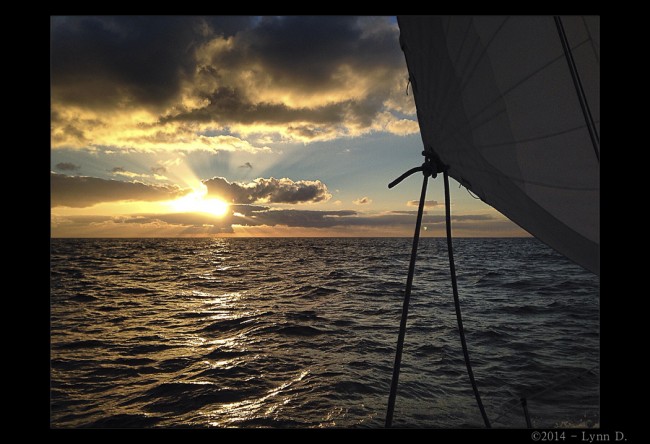 But for those little glimpses of time without full foulies on, it was truly enjoyable. And, not to sound like a fair-weather sailor, but… I mean, come on. When seven foot seas become the average rather than the exception, it makes it difficult to be functional let alone enjoy the ride. Of course, there are going to be good days and bad days on board, but the amount of Suck involved appears to be substantially more profound in the high-latitudes.
But for those little glimpses of time without full foulies on, it was truly enjoyable. And, not to sound like a fair-weather sailor, but… I mean, come on. When seven foot seas become the average rather than the exception, it makes it difficult to be functional let alone enjoy the ride. Of course, there are going to be good days and bad days on board, but the amount of Suck involved appears to be substantially more profound in the high-latitudes.
It is possible to eat well
I think a common misconception that we have heard put to us many times as a question is: “What do you eat?” On this trip, we regularly had tortellini, fajitas, or any number of pub foods with real fresh fruits and veggies on the side. Our gimbaled stove can handle about 30º of heel before maxing out which should take care of most normal tossing. We do eat quite a bit of soup or cold-cut sandwiches, but I think we do pretty well considering the prevailing conditions.
It is really (REALLY!) hard to see at sea
I’m not necessarily referring to the simple fact that it is dark: it is a profound, deep darkness that crosses into the physical. Not to be dramatic, but I mean it: you can just about feel the darkness. If you see a light, it is anywhere from a few feet to a few miles away. And often, you’ll watch the light for hours and hours as you approach it. Is it a boat? How big is it? Why are two buoys when there should be three; where’s the other one!? Is that the leading light? Is that light green or white? The cruising newbie in me was not fully aware of the amount of awareness it takes to move a 42ft yacht in a straight line from “here” to “there” beyond the horizon. Now I understand.
And don’t even get me started on the fog: 100ft visibility in a seaway is freaky.
Everything takes more effort on passage
There’s nothing inherently difficult about sitting at the dock. But practically everything is more difficult underway. Wanna stand up? Nope! Wanna go to the toilet without falling in the floor? Nope! Wanna get warm? Yeah, right! How about making a sandwich? Get the mustard all over the cockpit! Tie a simple bowline knot? Have some random intense nausea in 3…2…1…
But seriously, if not dealt with or taken into account, passages like this can be frustrating just due to the amount of effort it takes to do simple tasks. The mood onboard can quickly sour when frustration is allowed to fester and overflow. It is worth being careful for more reasons than just avoiding injury.
We miss Proteus… and worry about her
Proteus is not some unorthodox vacation house, it is our home. It has nothing to do with the fact that we have the world’s most comfortable bed and we get gently rocked to sleep every night. Nor is it related to the amazing variety of locations she takes us to. Being away and hearing from the guys taking care of her is like hearing from a child at summer camp. Or maybe it feels like we had to tie our puppy to a tree and leave it for a month. (Yeah… “awww…” is how we feel, too!)
It is a very strange feeling, in all honesty. But how would you feel if you left your house for a month? More than simply, “Oh, did I remember to turn the gas off?” we deal with thoughts of, “Oh, I wonder if a rope will break and she’ll float away?” or, “I wonder if we will return to her with the floorboards floating?” Owning and maintaining and living aboard a big yacht like this requires us to look at the situation as if we are caring for a living thing. She needs to be fed and kept warm and secure. I think some look at owning a yacht is equivalent to owning a car or a pleasure boat typically found on American lakes: it is wildly different.
Conclude…
Sailing is far from moving a boat. But before actually doing it, I had no idea how far from “moving a boat” this stuff actually is. Sailing and passagemaking is an enormous combination of things, both comfortable and uncomfortable. Nobody should be under the impression that it is all easy or relaxing: it is a lot of work.
I cannot wait to get back on the water…
At night with the Celtic Sea & the RNLI…
By: Noah D.
If you spend any time in marinas, ports, and coastal towns in the British Isles, there’s an acronym that seems to be everywhere. Literally. Go in any gas station, cafe, pub, ferry terminal, etc, and you’ll see something about the RNLI somewhere.
For my American readership – or those who are only familiar with the militarized USCG – it might come as a surprise that the RNLI is actually run as a not-for-profit charity. It is an NGO. Even more astounding to me is the fact that most of these guys are un-paid, but highly skilled, volunteers. Seeing them in action first-hand and then finding out that they’re doing it basically for free is truly amazing.
The Conditions
We headed out of Falmouth early on Monday morning. Just before 6am, actually. In England this time of year, that means two hours before dawn. Our weather window was a solid 48 hours and we were projected to arrive in Cork around 5pm the following day if we maintained a moderate speed. But the Atlantic fronts that were coming in were not expected to be overly strong, just a jump from 15kts to maybe 25kts of wind: certainly nothing that a reef in the main wouldn’t take care of. Well… as we rounded Lands End just before dark (4:30pm) and headed northwest toward Cork, Ireland, the wind shifted… to the northwest. This meant beating a due north course for a while in the deep darkness of the Bristol Channel.
This wasn’t that bad, either. The tides were with us and we were clocking an easy 6+kts in 15kts of air with precautionary reefs in the main and jib. I don’t think we saw 20kts flash on the anemometer the whole night and the seas were slight although with a normal North Atlantic swell. Add this with the VHF forecasts from the MET Office every three hours forecasting Force 4 to 5 that would be shifting from north-northwest toward the west and to the west-southwest… this was backed up by PassageWeather (checked via phone before we lost 3G service off Lands End). So, everything was looking good for our landfall.
Well… the winds only shifted around dawn and by that point we were quite far off our rhumb line. But they did shift! And we made straight for our destination on an easy, fast, port tack. There were a few moments we were hauling along over 7kts over the ground. We felt good! Tired, but good!
Around this time, we were out of range of the VHF aerials. We could hear the high-power HM Coast Guard announcements for the weather, but when we switched to the proper channel, the actual broadcast was too weak to make any sense. No matter… the forecasts all had been fine.
By the time we were in range of the Irish CG weather broadcasts, there was a Wind Warning and Small-craft Advisory in effect. This meant that there had been a new update superseding the previous mild conditions and moving up the bad weather almost a full six hours. Dark fell and we were at two reefs still pounding upwind and against the waves (but still making well over 5kts). We were less than 50 miles offshore and we decided to turn downwind and make for the closest coast. With the main down and flying a tiny scrap of headsail, we blew down wind and kept up with the building waves. We headed as close as we dared to quarter the following seas and the wind coming out of the west.
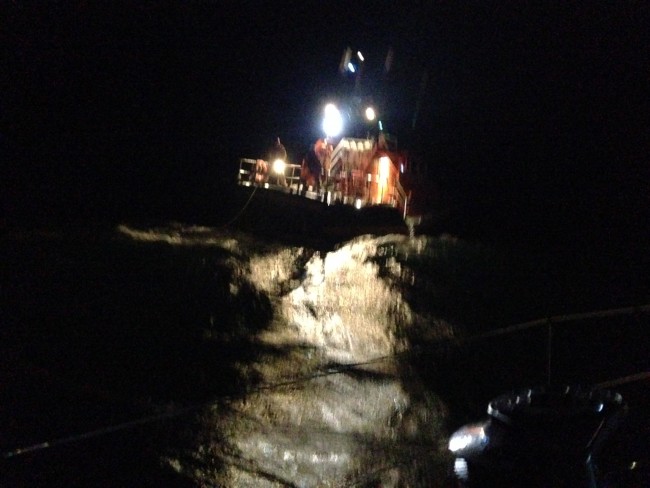 I was manually steering of course because no autopilot can handle stuff like that. So Lynn was reading aloud from the Reeds Almanac for a place to go. Around 20 miles offshore – also past 2200 hours – we attempted calling a marina before it got too late to see if we could reach a harbourmaster. When we called Kilmore Quay, the harbourmaster did not answer, but fishing vessel Mary Catherine broke in: “Nobody is there this time of night, but if you’ll go to Channel 12, I might could help you.”
I was manually steering of course because no autopilot can handle stuff like that. So Lynn was reading aloud from the Reeds Almanac for a place to go. Around 20 miles offshore – also past 2200 hours – we attempted calling a marina before it got too late to see if we could reach a harbourmaster. When we called Kilmore Quay, the harbourmaster did not answer, but fishing vessel Mary Catherine broke in: “Nobody is there this time of night, but if you’ll go to Channel 12, I might could help you.”
Again, I’m steering, and Lynn talked to F/V Mary Catherine on the VHF for a little while to find out information about the area and see what we could do about shelter. One of his suggestions was to call the Kilmore Quay lifeboat station and see what they recommend. Until now, I had only thought that the lifeboat was literally that: a boat to save lives. And, we certainly were not entering “life threatening” status yet. But, with an uncertain (but low-er) amount of fuel and still almost 3 hours off the coast, motoring upwind, into the current, and against the waves was a dubious prospect. We still bombed along at more than 7kts with barely any sail up.
It was about this time that I calculated that we were probably going to miss the southeastern tip of Ireland. Which would have put us many many more hours at sea before landing somewhere in Wales. If we passed around Tuskar Rock, there might be a chance of the seas calming down enough for us to motor upwind into Rosslare or Wexford, but still… it was a chance.
So, call the lifeboat station, we did. Of course, the Rosslare Coast Guard talked to us for a little while, and dispatched the lifeboat to see what assistance they could provide. By that point, the seas were ridiculous and the wind gusts were flashing 40kts… 42kts… Finally, instead of trying to transfer any fuel over to us, the decision was made to simply tow us the rest of the way in to Kilmore Quay. And, out they came. Like something from a movie, this massive powerboat, lit with millions of candlepower spotlights, came barreling out of the 4-5 meter seas as a tank might growl over rolling hills. They threw over a tow rope as big around as your forearm and drug all 24,000lbs of Proteus through Force 8-9 winds and huge waves the two hours to safety. In fact, it was like we weren’t even there: they pulled us at over 6kts for two hours as we held on for quite a wild ride. Not one I would ever want to take again, mind you.
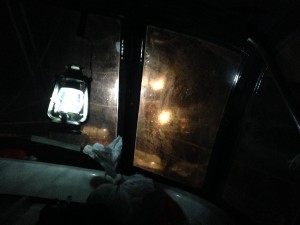 Now, sitting here at Kilmore Quay, we are fine. Proteus is fine (although a little shaken up, literally and figuratively). Some people say: “Respect the sea.” And, prior to this, I would have said: “Yes, I do respect the sea!” But that’s akin to reading all about travel and foreign lands without ever having set foot on a plane.
Now, sitting here at Kilmore Quay, we are fine. Proteus is fine (although a little shaken up, literally and figuratively). Some people say: “Respect the sea.” And, prior to this, I would have said: “Yes, I do respect the sea!” But that’s akin to reading all about travel and foreign lands without ever having set foot on a plane.
I tell you now: we sailors of Proteus, we respect the sea. I’ve lived near and on water my entire life, but no movies or books or photographs can tell you what it is really about out there. And, secondly, we respect the first-responders – the men of RNLI lifeboat 16-18 – that came out to make sure we made it into their harbour safely.
The Aftermath
So, you may wonder, how “at risk” were we really…
To be completely honest, any offshore passage like this is a risk. However, a powerful and well-equipped sailing vessel like Proteus cuts down those risks significantly. And – not meaning to sound at all prideful – but we took precautions a long time ago in our sailing studies and research that assisted us in heavy-weather sailing like what we experienced on the Celtic Sea: there is no substitute for knowing what to do in particular situations.
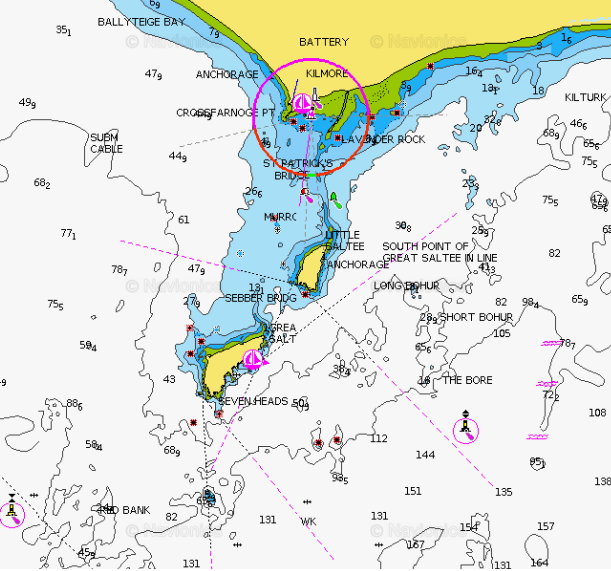 But, most importantly, we had the assistance of F/V Mary Catherine at first, then the Rosslare CG, and finally the guys at RNLI Kilmore Quay to come fill in the gaps to make sure that we never were classified as a “vessel in distress.”
But, most importantly, we had the assistance of F/V Mary Catherine at first, then the Rosslare CG, and finally the guys at RNLI Kilmore Quay to come fill in the gaps to make sure that we never were classified as a “vessel in distress.”
Proteus never took on water (except into the cockpit) and never suffered a knockdown, but the situations were such that the RNLI weren’t just making a milk run. Talking to the guys later at 3am tea, one of the lifeboat crew told me: “We’ve all been there.” Perhaps he was just being gracious, but if I’m taking steps to someday be as capable and as good of a seaman as the crew of the 16-18 by going through a Fastnet gale, I’m almost glad it all happened the way it did.
But… if it is up to me? Never again.
Could we have done anything differently? I’m actually not sure. Talking to a few people and analyzing the situation, it was a case of a winter North Atlantic frontal system doing its normal thing and saying: “Haha! You think you can predict me!? Gotcha!!” Had we kept significant spare fuel on board, I might have felt better about powerboating upwind and upwaves into such conditions. If we continued to live in the high-latitudes – which we have no intention of doing – we could have done well with a storm trysail and a storm jib. I feel fairly confident that the added stability of forward motion would have contributed to our comfort on board. Another option would have been to heave-to and wait it out. But by that point, the main was down and putting up a double-reefed main in those conditions would have been foolhardy.
A New Chapter Begins
We are young at this. I’ve been sailing more than a decade and this was my first true test of serious gale conditions. Even after 700 miles of sucky English winter weather, this ratcheted up the playing field considerably. However, the inexperienced become experienced through experience: not by reading books or by sitting at the quayside. Next time, it might be 800 miles offshore instead of a mere 12. The things we learned in this gale will keep us safe and make the difference when no lifeboats are on hand.
Our original destination was Cork, Ireland, to keep the boat over Christmas and the “worst of the winter weather” as we prepare for our Big Trip this spring. As luck would have it, I suppose, we could not have landed in a better place. Kilmore Quay has a relatively small marina, but it is a true, old-school, maritime village. It has everything that we need. So, this will be our base until we head south in the spring.
Lynn and I look forward to seeing flowers bloom and heading back toward the sun again. For that, stay tuned…
Between the storms: Ramsgate, Brighton, Cowes, Dartmouth…
By: Noah D.
Since our last post from Ramsgate, we’ve been clocking up the mileage. Ramsgate… past Dover in the wee hours of the morning… to Brighton briefly… then a brisk blow into the Solent and a stay at a buoy in Cowes… and finally, a really long haul all the way to Dartmouth in which we dodged crab pots, fishing trawlers, and motorsailed against the current to get us on the Dart River around 0330 in the morning.
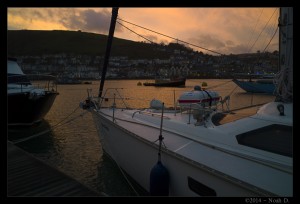 For the past few days, we’ve been reveling at the beauty of this place. Ye who hast never been outside of London has never been to England.
For the past few days, we’ve been reveling at the beauty of this place. Ye who hast never been outside of London has never been to England.
I, now, am the sailboat out at sea that is seen from Brighton, from the Portsmouth ferries, from across the twinkling hillsides of Dartmouth and Kingswear. Out of season and miles from shore, we are the sailors who are continuing on our way long after the sun goes down.
And, let me tell you… I’m not sure I understood darkness until I sailed at night for the first time. This is darkness you can feel. Even a large city on the horizon casts no glow far enough to reach Proteus. On a moonless sky, you can only see the deck of the boat and practically nothing else. Luckily, we had the moon with us crossing from Portland Bill to Dartmouth, but not so from Ramsgate rounding Dover. True darkness and miles from shore.
Ferries, I understand now, are sneaky: gigantic oceanliners, they can go from being a tiny spot on the horizon to filling your view in minutes.
But we have had some seriously good sailing days. Coming out of Brighton, we were under full sail and making great time. Also, leaving Cowes and sailing through the Needles, we almost touched 10kts over the ground with a four knot tide. Had we a little more wind, we could have easily hit double digits.
Now, we are waiting for the dreaded “Weather Bomb” to move through. It has dumped literally 50 foot waves into far northern Scotland. Some places have flashed into three digit windspeeds up north. Disgusting. But tomorrow, we will be moving on from this amazing place that we have really fallen in love with. Leave, we must.
Our clothes are clean and we are warm and fed well. The winds howl outside for a few more hours before we head farther west. Next, we are headed for Lands End and the 140nm passage in open ocean to Ireland beyond. Our time in England has drawn to a close.
For that, stay tuned…
We crossed the Prime Meridian, btw. We’ve done it dozens and dozens of times, of course, because it is in London. But this time, we sailed across… Proteus is now in The West.
Oh, and I don’t want to forget to mention: we were boarded by the Border Force! Right off Portland Bill, we saw a ship that inspired the comment: “That looks a lot like a battleship.” Well, it was a Border Force patrol boat. About that time, they launched a tender that quickly intercepted us. They boarded and we had a nice little chat, they checked all our papers, and left us in peace. Honestly, it was a rather pleasant experience and the crew was utterly professional. Of course, we had to wipe off a few heavy bootprints off the teak, but they’re doing their job and we were just passing through.
Sailing across the Thames Estuary…
For our first passage on this journey, we sailed across the Thames Estuary from Ipswich to Ramsgate. It was our first experience with open-water sailing of this nature, and what an experience it turned into!
You’ll have to pardon the light number of photos, a few other things consumed my time – like sailing! – and it got dark, of course, at 3:45pm as it does this time of year: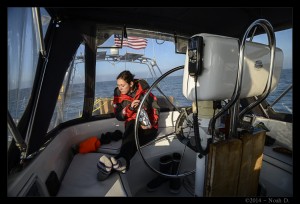
The first few hours of the day was in extraordinarily thick fog. Complete white-out, actually. For these first hours in my ship’s log, I believe I might have written in the “Visibility” category: none. Navigating barely buoy to buoy, we made our way down the River Orwell to Harwich. In the Harwich Harbor, we raised both sails and began our sail south.
Of course, navigating the Thames Delta is no brief glance, and, with a North-ish wind at about 10kts, we headed towards the south. We headed slightly east to avoid the constantly shifting sands, passing by Roughs Tower (or the Principality of Sealand) and just at the boundaries of the Sunk Precautionary Area where the not-so-aptly named Sunk Lightship sits in the center of one of the world’s largest roundabouts.
Imagine a roundabout that is so big that 300 meter container ships must make their way around: that’s the Sunk Precautionary Area.
Anyways, so around lunchtime, we caught the southbound current. It was like being on a conveyor belt. At one point, we topped 9kts over the ground. This conveyor belt was not to last. The sky got darker and darker and so did the tide. By the time we reached the Thanet Wind Farm – just a few hundred meters away – it was completely dark and the tide was setting against us. The wind farm looked light a giant city in the water, blinking all manner of lights.
We had been on one reef in the main for a while with sustained winds in the lower 20’s, but when the gusts started hitting 30kts and the following seas moved around to the starboard quarter, we went to a second reef and took in the headsail further.
Lynn had been feeling a bit under the weather just at dark and had gone below to lay down. She says she dozed off. When she awoke, she said she thought all hell had broken loose… the clothes that usually hang on the door were swinging wildly back and forth. The following seas and the winds were making for quite a rough ride.
As we approached Ramsgate and got within a mile of the coast, the wind slacked and the rolling eased and, though we were still against an almost 2kts current, we were still powering along at over 5kts. We came into the Ramsgate Harbour, moored, and slept.
The Subsequent Days
I’m sitting now at the galley table, feeling all warm and cozy. Outside, though, I’m listening to gale winds howl in the rigging and rock us back and forth with the substantial sea swell coming through the mouth of the harbour. The mooring lines catch us from the wind’s mindless shoves and the lines growl sharply on the cleats.
You might not think anything is out of the ordinary at all from the evidence in this photo. Only the wetness outside the window at the top right might give away that there is a serious storm outside. We’re hearing vessel traffic in the English Channel and pilots are delayed until the worst of the Force 8 winds burn themselves out.
We will stay hunkered down in the Ramsgate Harbour for another 24hrs or so and wait for the seas to chill. Because the sea has a good memory of the violence that is thrown across its surface.
Brighton is next. I hope you’ll stay tuned…
Deprecated: Function get_magic_quotes_gpc() is deprecated in /hermes/walnacweb05/walnacweb05an/b419/moo.haonavy/curiosity/wp-includes/formatting.php on line 4365
